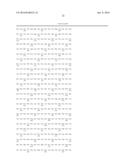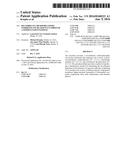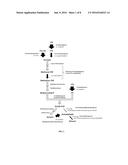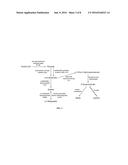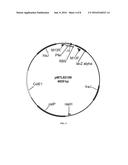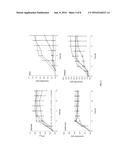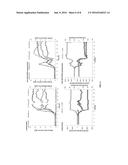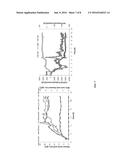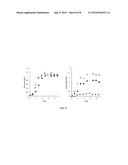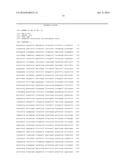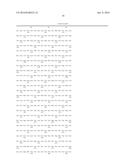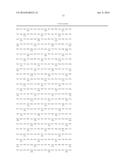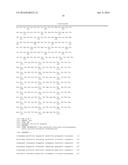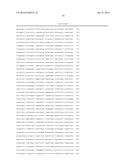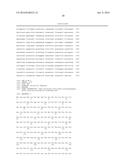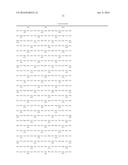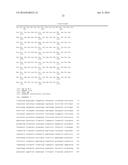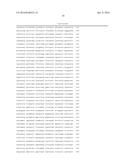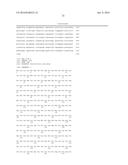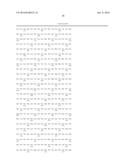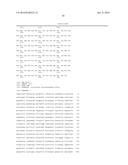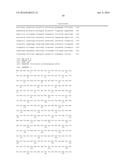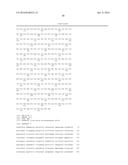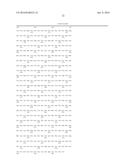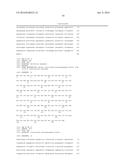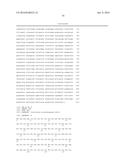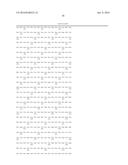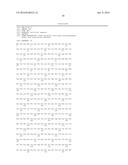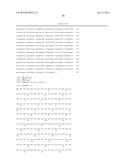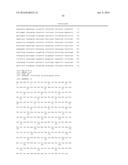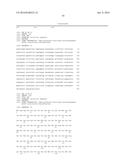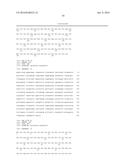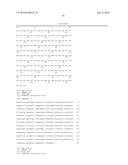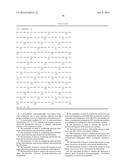Patent application title: RECOMBINANT MICROORGANISMS EXHIBITING INCREASED FLUX THROUGH A FERMENTATION PATHWAY
Inventors:
Michael Koepke (Skokie, IL, US)
Michael Koepke (Skokie, IL, US)
Alexander Paul Mueller (Skokie, IL, US)
Loan Phuong Tran (Skokie, IL, US)
IPC8 Class: AC12N1574FI
USPC Class:
435158
Class name: Containing hydroxy group acyclic polyhydric
Publication date: 2016-06-09
Patent application number: 20160160223
Abstract:
The invention provides a recombinant, carboxydotrophic Clostridium
bacterium that expresses one or more of pyruvate:ferredoxin
oxidoreductase (EC 1.2.7.1), acetolactate synthase (EC 2.2.1.6), and
acetolactate decarboxylase (EC 4.1.1.5). The invention further provides a
method of producing a fermentation product by fermenting the recombinant
bacterium in the presence of a gaseous substrate comprising CO to produce
one or more of ethanol, butanol, isopropanol, isobutanol, higher
alcohols, butanediol, 2,3-butanediol, succinate, isoprenoids, fatty
acids, biopolymers, and mixtures thereof.Claims:
1. A recombinant, carboxydotrophic Clostridium bacterium comprising one
or more enzymes selected from the group consisting of pyruvate:ferredoxin
oxidoreductase (EC 1.2.7.1), acetolactate synthase (EC 2.2.1.6), and
acetolactate decarboxylase (EC 4.1.1.5), wherein each enzyme is an
overexpressed endogenous enzyme, a mutated endogenous enzyme, or an
exogenous enzyme.
2. The bacterium of claim 1, comprising pyruvate:ferredoxin oxidoreductase and acetolactate synthase.
3. The bacterium of claim 1, comprising pyruvate:ferredoxin oxidoreductase and acetolactate decarboxylase.
4. The bacterium of claim 1, comprising acetolactate synthase and acetolactate decarboxylase.
5. The bacterium of claim 1, comprising pyruvate:ferredoxin oxidoreductase, acetolactate synthase, and acetolactate decarboxylase.
6. The bacterium of claim 1, wherein the enzyme is overexpressed endogenous pyruvate:ferredoxin oxidoreductase.
7. The bacterium of claim 1, wherein the enzyme is exogenous Desulfovibrio africanus pyruvate:ferredoxin oxidoreductase.
8. The bacterium of claim 1, wherein the enzyme is overexpressed endogenous IlvB ORF2059 acetolactate synthase, overexpressed endogenous IlvB ORF2336 acetolactate synthase, overexpressed endogenous IlvN acetolactate synthase, or overexpressed endogenous AlsS acetolactate synthase.
9. The bacterium of claim 1, wherein the enzyme is mutated endogenous IlvN acetolactate synthase.
10. The bacterium of claim 1, wherein the enzyme is exogenous Bacillus subtilis acetolactate synthase.
11. The bacterium of claim 1, wherein the enzyme is overexpressed endogenous AlsD acetolactate decarboxylase or overexpressed endogenous BudA acetolactate decarboxylase.
12. The bacterium of claim 1, wherein the enzyme is exogenous Aeromonas hydrophila acetolactate decarboxylase.
13. The bacterium of claim 1, wherein the enzyme is exogenous Leuconostoc lactis acetolactate decarboxylase.
14. The bacterium of claim 1, wherein the bacterium is derived from Clostridium autoethanogenum, Clostridium ljungdahlii, or Clostridium ragsdalei.
15. The bacterium of claim 1, wherein the bacterium is derived from Clostridium autoethanogenum.
16. The bacterium of claim 1, wherein the bacterium is derived from Clostridium autoethanogenum deposited under DSMZ Accession No. DSM23693.
17. A method of producing a fermentation product, comprising fermenting the bacterium of claim 1 in the presence of a gaseous substrate comprising CO to produce a fermentation product.
18. The method of claim 17, wherein the fermentation product is selected from the group consisting of ethanol, butanol, isopropanol, isobutanol, higher alcohols, butanediol, 2,3-butanediol, succinate, isoprenoids, fatty acids, biopolymers, and mixtures thereof.
19. The method of claim 18, wherein the fermentation product is 2,3-butanediol.
Description:
CROSS REFERENCE TO RELATED APPLICATIONS
[0001] This application claims the benefit of U.S. Patent Application 62/089,053 filed Dec. 8, 2014 and U.S. Patent Application 62/168,969 filed Jun. 1, 2015, the entirety of which are incorporated herein by reference.
BACKGROUND
[0002] Carboxydotrophic microorganisms may be engineered to produce products, such as fuels and chemicals, through fermentation of a gaseous substrate. Efforts to improve product concentration and substrate utilization have historically focused on strain selection and optimization of fermentation conditions (Abubackar, Bioresour Technol, 114: 518-522, 2012). The metabolism of natural microorganisms, however, did not evolve to achieve commercial objectives of high yields, rates, and titers, such that certain commercial objectives cannot be achieved through mere strain selection and optimization of fermentation conditions. Accordingly, there remains a need for improved microorganisms and methods for the production of useful products, such as fuels and chemicals.
SUMMARY OF THE INVENTION
[0003] The invention provides a recombinant, carboxydotrophic Clostridium bacterium comprising one or more enzymes selected from the group consisting of pyruvate:ferredoxin oxidoreductase (EC 1.2.7.1), acetolactate synthase (EC 2.2.1.6), and acetolactate decarboxylase (EC 4.1.1.5), wherein each enzyme is an overexpressed endogenous enzyme, a mutated endogenous enzyme, or an exogenous enzyme. The recombinant bacterium may express one, two, or all three of these enzymes.
[0004] The recombinant bacterium may be derived from any Clostridium microorganism. In one embodiment, the recombinant bacterium is derived from C. autoethanogenum, C. ljungdahlii, or C. ragsdalei. In a preferred embodiment, the recombinant bacterium is derived from C. autoethanogenum deposited under DSMZ Accession No. DSM23693 (C. autoethanogenum LZ1561).
[0005] The invention further provides a method of producing a fermentation product, comprising fermenting the recombinant bacterium in the presence of a gaseous substrate comprising CO to produce one or more of ethanol, butanol, isopropanol, isobutanol, higher alcohols, butanediol, 2,3-butanediol, succinate, isoprenoids, fatty acids, biopolymers, and mixtures thereof.
BRIEF DESCRIPTION OF THE DRAWINGS
[0006] FIG. 1 is a flux map of the ethanol biosynthesis pathway detailing the measured enzyme activities and flux through a carboxydotrophic microorganism for ethanol formation via acetyl-CoA, which allows for the identification of rate-limiting pathway reactions. The thickness of the arrows is proportional to the activity of the particular pathway reaction.
[0007] FIG. 2 is a flux map detailing the measured enzyme activities and flux through a carboxydotrophic microorganism for 2,3-butanediol formation via pyruvate, which allows for the identification of rate-limiting pathway reactions.
[0008] FIG. 3 is a diagram showing the 2,3-butanediol pathway and the associated branched-chain amino acid biosynthesis pathway. Pyruvate is converted to .alpha.-acetolactate, the intermediate for both the 2,3-butanediol and the branched-chain amino acid biosynthesis pathways. Experiments were performed to overexpress PFOR, alsS and alsD.
[0009] FIG. 4 is a schematic representation of the pMTL83159 plasmid. The plasmid contains a Gram negative origin of replication (ColE1) gene, a Gram positive origin of replication (repH) gene, the transfer gene traJ, the catP gene encoding for the chloramphenicol/thiamphenicol resistance, a multiple cloning site locating within lacZ alpha coding sequence and, a ferredoxin gene promoter (P.sub.fdx).
[0010] FIG. 5 is a set of graphs showing of the growth and metabolite profiles (biomass, 2,3-butanediol (BDO), acetic acid, and ethanol) versus time of five strains grown in Schott bottles.
[0011] FIG. 6 is a set of graphs showing the metabolite profile (top graphs) and gas profile (bottom graphs) of the combined PFOR, alsS and alsD overexpression strain and the plasmid control strain at a 4 mol/L/d CO uptake over the course of 20 days.
[0012] FIG. 7 is a set of graphs showing the metabolite and the gas profiles of the overexpression culture at an 8 mol/L/d CO uptake over the course of 11 days.
[0013] FIG. 8 is a set of graphs showing biomass and butanediol production of cultures expressing A. hydrophila alsD (open squares), L. lactis alsD (closed squares), and empty plasmid control (triangles). Values are the average of three replicates and error bars represent one standard deviation.
DETAILED DESCRIPTION OF THE INVENTION
[0014] A fermentation pathway is a cascade of biochemical reactions (pathway reactions) by which a substrate, preferably a gaseous substrate, is converted to a fermentation product. Pathway reactions typically involve enzymes that catalyse or increase the rate of the pathway reaction.
[0015] "Flux" refers to the flow of metabolites through one or more reactions in a fermentation pathway. The flux through individual pathway reactions has an upper and lower limit. Therefore, the flux may be changed by adjusting conditions or factors that affect enzymatic activity. Adjustment of the flux through one pathway reaction may alter the overall flux of the fermentation pathway. Flux may be measured according to any method known in the art. By way of example, flux may be measured using flux-balance analysis (FBA) (Gianchandani, Systems Biol Medicine, 2: 372-382, 2010). Flux through the pathway may also be measured by the level of metabolites and products (metabolomics) (Patti, Nat Rev Molec Cell Biol, 13: 263-269, 2012) and/or labelling experiments as C13 (fluxomics) (Niittylae, Methods Mol Biol, 553: 355-372, 2009; Tang, Mass Spectrom Rev, 28:362-375, 2009).
[0016] The efficiency of a fermentation pathway can be increased by increasing the reaction flux through the pathway. The increased flux results in one or more of: an increased rate of growth of microorganisms performing the fermentation, an increased rate of growth and/or product production rate at elevated product concentrations, an increased fermentation product concentration in the fermentation broth, an increased volume of fermentation product produced per volume of substrate consumed, an increased rate of production or level of production of the fermentation product. Preferably, the increased efficiency results in an increased fermentation product production rate.
[0017] One method to identify rate limiting reactions (bottlenecks) is to measure enzyme activities for all reactions involved in the fermentation pathway from substrate to product. This can be done by analysing the enzymatic activity of reactions in cells growing under process conditions to identify the reactions with the lowest rates. These can then be adjusted so as not to be rate limiting, thus increasing the flux throughout the system. Enzymatic activity may be measured by any method known in the art, such as the methods described in Huang, J Bacteriol, 194: 3689-3699, 2012.
[0018] The inventors have analysed the activity of enzymes involved in fermentation pathways and found that some pathway reactions exhibit substantially lower enzymatic activity than other reactions in the same pathway. The recombinant microorganisms and methods described herein have particular utility for pathways where the product yield in a parental microorganism may lack the product yield to be a viable commercial target.
[0019] Examples of fermentation pathways that are amenable to analysis of enzyme activity include the Wood-Ljungdahl pathway, fermentation pathways to produce ethanol, 2,3-butanediol or a precursor thereof such as acetyl-CoA and pyruvate, and biosynthesis pathways for cofactors tetrahydrofolate and cobalamine (B.sub.12) which may be required in fermentation pathways. The Wood-Ljungdahl pathway is composed of a number of reactions catalysed by enzymes, as described in FIG. 1 and FIG. 2. The steps subsequent to the Wood-Ljungdahl pathway which lead to the production of desirable fermentation products are also considered to be part of the fermentation pathway. In a particular embodiment, the fermentation pathway results in the production of a fermentation product selected from the group consisting of ethanol, butanol, isopropanol, isobutanol, higher alcohols, butanediol, 2,3-butanediol, succinate, isoprenoids, fatty acids, biopolymers, and mixtures thereof.
[0020] The invention provides a recombinant, carboxydotrophic Clostridium bacterium comprising one or more enzymes selected from the group consisting of pyruvate:ferredoxin oxidoreductase (EC 1.2.7.1), acetolactate synthase (EC 2.2.1.6), and acetolactate decarboxylase (EC 4.1.1.5), wherein each enzyme is an overexpressed endogenous enzyme, a mutated endogenous enzyme, or an exogenous enzyme.
[0021] A "parental microorganism" is a microorganism used to generate a recombinant microorganism of the invention. The parental microorganism may be one that occurs in nature (i.e., a wild type microorganism) or one that has been previously modified (i.e. a recombinant microorganism). The recombinant microorganisms of the invention may be modified to express or overexpress one or more enzymes that were or were not expressed or overexpressed in the parental microorganism, or may be modified to exhibit increased availability of one or more co-factors. In one embodiment, the parental organism may be C. autoethanogenum, C. ljungdahlii, or C. ragsdalei. In a particularly preferred embodiment, the parental organism is C. autoethanogenum LZ1561, which is deposited under DSMZ accession DSM23693.
[0022] A "recombinant microorganism" is a microorganism that has undergone genetic modification when compared to a parental microorganism. Genetic modification includes insertion, deletion, or substitution of nucleic acids, for example.
[0023] In general, the term "derived from" indicates that a nucleic acid, protein, or microorganism is modified or adapted from a different (i.e., a parental or wild-type) nucleic acid, protein, or microorganism, respectively, so as to produce a new recombinant microorganism.
[0024] Methods of genetic modification of a parental microorganism include molecular methods such as heterologous gene expression, genome insertion or deletion, altered gene expression or inactivation of genes, or enzyme engineering methods. Such techniques are described, for example, in Sambrook, Molecular Cloning: A Laboratory Manual, Cold Spring Harbor Laboratory Press, Cold Spring Harbor, N.Y., 2001; Pleiss, Curr Opin Biotechnol, 22: 611-617, 2011; Park, Protein Engineering and Design, CRC Press, 2010. Expression constructs/vectors may contain, for example, one or more promoters or ribosomal binding sites. Nucleic acids and construct/vector sequences described herein may also contain standard linker nucleotides such as those required for ribosome binding sites and/or restriction sites.
[0025] Nucleic acids and nucleic acid constructs, including expression constructs/vectors of the invention may be constructed using any method known in the art. For example, chemical synthesis or recombinant techniques may be used. Such techniques are described, for example, in Sambrook, Molecular Cloning: A Laboratory Manual, Cold Spring Harbor Laboratory Press, Cold Spring Harbor, N. Y., 1989. Essentially, the individual genes and regulatory elements may be operably linked to one another such that the genes can be expressed to form the desired proteins. Suitable vectors will be appreciated by those of ordinary skill in the art. However, by way of example, the following vectors may be suitable: pMTL80000 vectors, pIMP1, pJIR750, and other plasmids.
[0026] Nucleic acids may be delivered to a microorganism using any method known in the art. For example, nucleic acids may be delivered to a microorganism as naked nucleic acids or may be formulated with one or more agents (e.g., liposomes) to facilitate the transformation process to the microorganism. The nucleic acids may be DNA, RNA, cDNA, or combinations thereof, as is appropriate. Restriction inhibitors may be used in certain embodiments (Murray, Microbiol Molec Biol Rev, 64: 412-434, 2000). Additional vectors include include plasmids, viruses (including bacteriophage), cosmids, and artificial chromosomes. In a preferred embodiment, nucleic acids are delivered to a microorganism using a plasmid. By way of example only, transformation (including transduction or transfection) may be achieved by electroporation, ultrasonication, polyethylene glycol-mediated transformation, chemical or natural competence, protoplast transformation, prophage induction or conjugation. Suitable transformation techniques are described for example in, Sambrook, Molecular Cloning: A Laboratory Manual, Cold Spring Harbor Laboratory Press, Cold Spring Harbor, N. Y., 1989.
[0027] The use of electroporation has been reported for several carboxydotrophic acetogens, including C. ljungdahlii (Koepke, PNAS, 107:13087-13092, 2010; WO/2012/053905), C. autoethanogenum (WO/2012/053905), C. aceticum (Schiel-Bengelsdorf, Synthetic Biol, 15: 2191-2198, 2012), and A. woodii (Stratz, Appl Environ Microbiol, 60: 1033-1037, 1994). The use of electroporation has also been reported in Clostridia, including C. acetobutylicum (Mermelstein, Biotechnol, 10: 190-195, 1992), and C. cellulolyticum (Jennert, Microbiol, 146: 3071-3080, 2000). Additionally, prophage induction has been demonstrated for carboxydotrophic acetogens, including C. scatologenes (Parthasarathy, Development of a Genetic Modification System in Clostridium scatologenes ATCC 25775 for Generation of Mutants, Masters Project, Western Kentucky University, 2010), and conjugation has been described for many Clostridia, including C. difficile (Herbert, FEMS Microbiol Lett, 229: 103-110, 2003) and C. acetobuylicum (Williams, J Gen Microbiol, 136: 819-826, 1990). Similar methods could be used in carboxydotrophic acetogens.
[0028] The invention provides a recombinant carboxydotrophic Clostridium bacterium adapted to exhibit increased flux through a fermentation pathway relative to a parental microorganism. In one particular embodiment of the invention, the parental microorganism is selected from the group of carboxydotrophic Clostridia comprising C. autoethanogenum, C. ljungdahlii, C. ragsdalei, C. carboxidivorans, C. drakei, C. scatologenes, C. aceticum, C. formicoaceticum, and C. magnum.
[0029] The recombinant bacterium may be derived from the cluster of carboxydotrophic Clostridia comprising the species C. autoethanogenum, C. ljungdahlii, C. ragsdalei, and related isolates. These include but are not limited to strains C. autoethanogenum JAI-1T (DSM10061) (Abrini, Arch Microbiol, 161: 345-351, 1994), C. autoethanogenum LBS1560 (DSM19630) (WO 2009/064200), C. autoethanogenum LZ1561 (DSM23693), C. ljungdahlii PETCT (DSM13528=ATCC 55383) (Tanner, Int J Syst Bacteriol, 43: 232-236, 1993), C. ljungdahlii ERI-2 (ATCC 55380) (U.S. Pat. No. 5,593,886), C. ljungdahlii C-01 (ATCC 55988) (U.S. Pat. No. 6,368,819), C. ljungdahlii O-52 (ATCC 55989) (U.S. Pat. No. 6,368,819), C. ragsdalei P11T (ATCC BAA-622) (WO 2008/028055), related isolates such as "C. coskatii" (U.S. Publication 2011/0229947), or mutated strains such as C. ljungdahlii OTA-1 (Tirado-Acevedo, Production of Bioethanol from Synthesis Gas Using Clostridium ljungdahlii, PhD thesis, North Carolina State University, 2010). These strains form a subcluster within the Clostridial rRNA cluster I, and their 16S rRNA gene is more than 99% identical with a similar low GC content of around 30%. However, DNA-DNA reassociation and DNA fingerprinting experiments showed that these strains belong to distinct species (WO 2008/028055). The strains of this cluster are defined by common characteristics, having both a similar genotype and phenotype, and they all share the same mode of energy conservation and fermentative metabolism. The strains of this cluster lack cytochromes and conserve energy via an Rnf complex.
[0030] All species of the above-referenced cluster have a similar morphology and size (logarithmic growing cells are between 0.5-0.7.times.3-5 .mu.m), are mesophilic (optimal growth temperature between 30-37.degree. C.), and are strictly anaerobic (Abrini, Arch Microbiol, 161: 345-351, 1994; Tanner, Int J Syst Bacteriol, 43: 232-236, 1993; and WO 2008/028055). Moreover, they all share the same major phylogenetic traits, such as same pH range (pH 4-7.5, with an optimal initial pH of 5.5-6), strong autotrophic growth on CO-containing gases with similar growth rates, and a similar metabolic profile with ethanol and acetic acid as main fermentation end products, and small amounts of 2,3-butanediol and lactic acid formed under certain conditions (Abrini, Arch Microbiol, 161: 345-351, 1994; Kopke, Curr Opin Biotechnol, 22: 320-325, 2011; Tanner, Int J Syst Bacteriol, 43: 232-236, 1993; and WO 2008/028055). Indole production was observed with all three species as well. However, the species differentiate in substrate utilization of various sugars (e.g., rhamnose, arabinose), acids (e.g., gluconate, citrate), amino acids (e.g., arginine, histidine), or other substrates (e.g., betaine, butanol). Moreover some of the species were found to be auxotrophic to certain vitamins (e.g., thiamine, biotin) while others were not. The organization and number of Wood-Ljungdahl pathway genes, responsible for gas uptake, has been found to be the same in all species, despite differences in nucleic and amino acid sequences (Kopke, Curr Opin Biotechnol, 22: 320-325, 2011). Also, reduction of carboxylic acids into their corresponding alcohols has been shown in a range of these microorganisms (Perez, Biotechnol Bioeng, 110:1066-1077, 2012). These traits are therefore not specific to one organism like C. autoethanogenum or C. ljungdahlii, but rather general traits for carboxydotrophic, ethanol-synthesizing Clostridia and it can be anticipated that mechanisms work similarly across these strains, although there may be differences in performance.
[0031] In one embodiment, the parental microorganism is C. autoethanogenum, C. ljungdahlii, or C. ragsdalei. Preferably, the parental microorganism is wild-type C. autoethanogenum or C. autoethanogenum deposited under DSMZ accession number DSM10061 or DSM23693 (C. autoethanogenum LZ1561). In one embodiment, the recombinant bacterium is derived from C. autoethanogenum, C. ljungdahlii, or C. ragsdalei. Preferably, the recombinant bacterium is derived from wild-type C. autoethanogenum or C. autoethanogenum deposited under DSMZ accession number DSM23693 (C. autoethanogenum LZ1561).
[0032] The enzymes and genes of the invention may be overexpressed endogenous enzymes and genes, mutated endogenous enzymes and genes, or exogenous enzymes and genes.
[0033] "Endogenous" refers to a nucleic acid or protein that is present in the wild-type or parental bacterium from which the recombinant bacterium of the invention is derived. In one embodiment, the expression of an endogenous gene may be controlled by an exogenous regulatory element, such as an exogenous promoter.
[0034] "Exogenous" refers to a nucleic acid or protein that is not present in the wild-type or parental bacterium from which the recombinant bacterium of the invention is derived. In one embodiment, an exogenous gene or enzyme may be derived from a heterologous strain or species and introduced to or expressed in the recombinant bacterium. In another embodiment, an exogenous gene or enzyme may be artificially or recombinantly created. Exogenous nucleic acids may be adapted to integrate into the genome of the bacterium or to remain in an extra-chromosomal state in the bacterium, for example, in a plasmid.
[0035] "Enzyme activity" refers broadly to enzymatic activity, including, but not limited, to the activity of an enzyme, the amount of an enzyme, or the availability of an enzyme to catalyse a reaction. Accordingly, "increasing" enzyme activity includes an increase in the activity of an enzyme, an increase in the amount of an enzyme, or an increase in the availability of an enzyme to catalyse a reaction.
[0036] The genes and enzymes of the invention may be developed or engineered using any method known in the art, including, for example, directed evolution, knowledge-based design, random mutagenesis methods, gene shuffling, codon optimization, use of site-specific libraries, and use of site evaluation libraries.
[0037] "Mutated" refers to a nucleic acid or protein that has been modified in the recombinant bacterium of the invention compared to the wild-type or parental bacterium from which the recombinant bacterium of the invention is derived. In one embodiment, the mutation may be a deletion, insertion, or substitution in a gene encoding an enzyme. In another embodiment, the mutation may be a deletion, insertion, or substitution of one or more amino acids in an enzyme.
[0038] "Codon optimization" refers to the mutation of a nucleic acid, such as a gene, for optimized or improved translation of the nucleic acid in a particular strain or species. Codon optimization may result in faster translation rates or higher translation accuracy. In a preferred embodiment, the genes encoding the enzymes of the invention are codon optimized for expression in Clostridium, particularly C. autoethanogenum, C. ljungdahlii, and/or C. ragsdalei. In a further preferred embodiment, the genes encoding the enzymes of the invention are codon optimized for expression in C. autoethanogenum LZ1561.
[0039] "Overexpressed" refers to any increase in expression of a nucleic acid or protein in the recombinant bacterium of the invention compared to the wild-type or parental bacterium from which the recombinant bacterium of the invention is derived. Overexpression may be achieved by any means known in the art, including modifying gene copy number, gene transcription rate, gene translation rate, or enzyme degradation rate.
[0040] "Overexpressed endogenous enzyme" refers to an endogenous enzyme that is present at higher levels in the recombinant bacterium of the invention compared to the wild-type or parental bacterium from which the recombinant bacterium of the invention is derived. The overexpressed endogenous enzyme may likewise be encoded by an endogenous gene, which may be modified, for example, to be controlled by a strong or constitutive promoter. Similarly, "overexpressed endogenous gene" refers to an endogenous gene that is present or transcripted at higher rates or levels in the recombinant bacterium of the invention compared to the wild-type or parental bacterium from which the recombinant bacterium of the invention is derived.
[0041] "Mutated endogenous enzyme" refers to an endogenous enzyme that is mutated or modified in the recombinant bacterium of the invention compared to the wild-type or parental bacterium from which the recombinant bacterium of the invention is derived. Similarly, "mutated endogenous gene" refers to an endogenous gene that is mutated or modified in the recombinant bacterium of the invention compared to the wild-type or parental bacterium from which the recombinant bacterium of the invention is derived.
[0042] "Exogenous enzyme" refers to an enzyme that is not present in the wild-type or parental bacterium from which the recombinant bacterium of the invention is derived. Similarly, "exogenous gene" refers to a gene that is not present in the wild-type or parental bacterium from which the recombinant bacterium of the invention is derived. Typically, the exogenous enzyme or gene is derived from a heterologous strain or species and introduced to or expressed in the recombinant bacterium.
[0043] The invention may be practiced using variant nucleic acids or proteins whose sequence varies from the sequences specifically exemplified herein provided they perform substantially the same function. For nucleic acid sequences that encode a protein or peptide this means that the encoded protein or peptide has substantially the same function. For nucleic acid sequences that represent promoter sequences, the variant sequence will have a similar ability to promote expression of one or more genes. Such nucleic acids or proteins may be referred to herein as "functionally equivalent variants." By way of example, functionally equivalent variants of a nucleic acid include allelic variants, fragments of a gene, genes which include mutations (deletion, insertion, nucleotide substitutions and the like) and/or polymorphisms and the like. Homologous genes from other microorganisms may also be considered examples of functionally equivalent variants of the sequences specifically exemplified herein. These include homologous genes in species such as C. acetobutylicum, C. beijerinckii, or C. ljungdahlii, the details of which are publicly available on websites such as Genbank or NCBI. Functionally equivalent variants also includes nucleic acids whose sequence varies as a result of codon optimization for a particular organism. A functionally equivalent variant of a nucleic acid will preferably have at least approximately 70%, approximately 80%, approximately 85%, approximately 90%, approximately 95%, approximately 98%, or greater nucleic acid sequence identity with the specified nucleic acid. A functionally equivalent variant of a protein will preferably have at least approximately 70%, approximately 80%, approximately 85%, approximately 90%, approximately 95%, approximately 98%, or greater amino acid identity with the specified protein. Such variants include a fragment of a protein or peptide wherein the fragment comprises a truncated form of the protein or peptide wherein deletions may be from 1 to 5, to 10, to 15, to 20, to 25 amino acids, and may extend from residue 1 through 25 at either terminus of the polypeptide, and wherein deletions may be of any length within the region or may be at an internal location. The functional equivalence of a variant nucleic acid or protein may be evaluated using any method known in the art. However, by way of example, assays to test for the activity of certain enzymes are described in Huang, J Bacteriol, 194: 3689-3699, 2012.
[0044] In certain embodiments having active restriction enzyme systems, it may be necessary to methylate a nucleic acid before introduction of the nucleic acid into a microorganism.
[0045] Generally, methylation is performed using a shuttle microorganism, preferably a restriction negative shuttle microorganism, such as E. coli, B. subtillis, or L. lactis, that facilitates the methylation of the nucleic acid sequences that make up the expression construct/vector. The methylation construct/vector comprises a nucleic acid sequence encoding a methyltransferase. Once the expression construct/vector and the methylation construct/vector are introduced into the shuttle microorganism, the methyltransferase gene present on the methylation construct/vector is induced. Induction may be by any suitable promoter system although in one particular embodiment of the invention, the methylation construct/vector comprises an inducible lac promoter and is induced by addition of lactose or an analogue thereof, more preferably isopropyl-.beta.-D-thio-galactoside (IPTG). Other suitable promoters include the ara, tet, or T7 system. In a further embodiment, the methylation construct/vector promoter is a constitutive promoter.
[0046] In a particular embodiment, the methylation construct/vector has an origin of replication specific to the identity of the shuttle microorganism so that any genes present on the methylation construct/vector are expressed in the shuttle microorganism. Preferably, the expression construct/vector has an origin of replication specific to the identity of the destination microorganism so that any genes present on the expression construct/vector are expressed in the destination microorganism.
[0047] Expression of the methyltransferase enzyme results in methylation of the genes present on the expression construct/vector. The expression construct/vector may then be isolated from the shuttle microorganism according to any method known in the art. In one embodiment, both construct/vector are concurrently isolated. The expression construct/vector may be introduced into the destination microorganism using any method known in the art. Since the expression construct/vector is methylated, the nucleic acid sequences present on the expression construct/vector are able to be incorporated into the destination microorganism and be successfully expressed.
[0048] A methyltransferase gene may be introduced into a shuttle microorganism and overexpressed. Thus, in one embodiment, the resulting methyltransferase enzyme may be collected using known methods and used in vitro to methylate an expression plasmid. The expression construct/vector may then be introduced into the destination microorganism for expression. In another embodiment, the methyltransferase gene is introduced into the genome of the shuttle microorganism followed by introduction of the expression construct/vector into the shuttle microorganism, isolation of one or more constructs/vectors from the shuttle microorganism and then introduction of the expression construct/vector into the destination microorganism.
[0049] The expression construct/vector and the methylation construct/vector may be combined to provide a composition of matter. Such a composition has particular utility in circumventing restriction barrier mechanisms to produce the recombinant microorganisms of the invention. In one particular embodiment, the expression construct/vector and/or the methylation construct/vector are plasmids. A number of suitable methyltransferases may be used, including, for example, B. subtilis phage .PHI.TI methyltransferase or the methyltransferase described in WO 2012/053905. Similarly, a number of constructs/vectors adapted to allow expression of a methyltransferase gene may be used to generate the methylation construct/vector.
[0050] By way of example, in one embodiment, a recombinant microorganism of the invention may be produced by a method comprising (a) introduction into a shuttle microorganism of (i) of an expression construct/vector comprising a nucleic acid as described herein and (ii) a methylation construct/vector comprising a methyltransferase gene; and (b) expression of the methyltransferase gene; isolation of one or more constructs/vectors from the shuttle microorganism; and introduction of the one or more construct/vector into a destination microorganism. In one embodiment, the methyltransferase gene of step (b) is expressed constitutively. In another embodiment, expression of the methyltransferase gene of step (b) is induced.
[0051] The recombinant bacterium of the invention comprises one or more of pyruvate:ferredoxin oxidoreductase, acetolactate synthase, and acetolactate decarboxylase.
[0052] Pyruvate:ferredoxin oxidoreductase (PFOR or POR) (EC 1.2.7.1) is an enzyme belonging to a family of oxidoreductases that catalyses the transfer of electrons from one molecule (the reductant, or electron donor) to another (the oxidant, or electron acceptor). Specifically, pyruvate:ferredoxin oxidoreductase catalyses the interconversion of pyruvate and acetyl-CoA: pyruvate+CoA+2 oxidized ferredoxinacetyl-CoA+CO.sub.2+2 reduced ferredoxin+2 H.sup.+. Conversion of acetyl-CoA to pyruvate links the Wood-Ljungdahl pathway of autotrophic CO(2) fixation to the reductive tricarboxylic acid cycle, which in autotrophic anaerobes is the stage for biosynthesis of all cellular macromolecules (Furdi, J Biol Chem, 15: 28494-28499, 2000). Pyruvate:ferredoxin oxidoreductase may also be known as pyruvate:ferredoxin 2-oxidoreductase (CoA-acetylating), pyruvate oxidoreductase, pyruvate synthase, pyruvate synthetase, or pyruvic-ferredoxin oxidoreductase.
[0053] The pyruvate:ferredoxin oxidoreductase enzyme of the invention may be an overexpressed endogenous enzyme, a mutated endogenous enzyme, or an exogenous enzyme. Similarly, the pyruvate:ferredoxin oxidoreductase enzyme of the invention may be encoded by an endogenous pyruvate:ferredoxin oxidoreductase gene that has been engineered for overexpression, may be encoded by a mutated endogenous pyruvate:ferredoxin oxidoreductase gene, or may be encoded by an exogenous pyruvate:ferredoxin oxidoreductase gene. In a preferred embodiment, the pyruvate:ferredoxin oxidoreductase enzyme is overexpressed endogenous pyruvate:ferredoxin oxidoreductase, such as overexpressed endogenous C. autoethanogenum, C. ljungdahlii, or C. ragsdalei pyruvate:ferredoxin oxidoreductase. Pyruvate:ferredoxin oxidoreductase enzymes are often unstable in the presence of oxygen. In a preferred embodiment, the pyruvate:ferredoxin oxidoreductase enzyme is oxygen stable or demonstrates at least some degree of oxygen insensitivity. In a further preferred embodiment, the pyruvate:ferredoxin oxidoreductase enzyme is exogenous Desulfovibrio africanus pyr/uvate:ferredoxin oxidoreductase, or an enzyme derived therefrom. Expression of D. africanus pyruvate:ferredoxin oxidoreductase has been demonstrated in E. coli (Pieulle, J Bacteriol, 179: 5684-5692, 1997), but not in a Clostridium microorganism.
[0054] Acetolactate synthase (Als) (EC 2.2.1.6) is an enzyme that catalyses the first step in the synthesis of branched-chain amino acids, such as valine, leucine, and isoleucine. In particular, acetolactate synthase is a transketolase that has both catabolic and anabolic forms, and catalyses the conversion of two pyruvate molecules to an acetolactate molecule and carbon dioxide: 2 CH.sub.3COCOO.sup.-CH.sub.3COCOHCH.sub.3COO.sup.-+CO.sub.2. Acetolactate synthase may also be known as acetohydroxy acid synthase.
[0055] The acetolactate synthase enzyme of the invention may be an overexpressed endogenous enzyme, a mutated endogenous enzyme, or an exogenous enzyme. Similarly, the acetolactate synthase enzyme of the invention may be encoded by an endogenous acetolactate synthase gene that has been engineered for overexpression, may be encoded by a mutated endogenous acetolactate synthase gene, or may be encoded by an exogenous acetolactate synthase gene. The acetolactate synthase may be anabolic or catabolic. In a preferred embodiment, the acetolactate synthase enzyme is overexpressed endogenous acetolactate synthase, such as overexpressed endogenous C. autoethanogenum, C. ljungdahlii, or C. ragsdalei acetolactate synthase. In particular, the acetolactate synthase enzyme may be overexpressed endogenous IlvB, ILvB ORF2059, IlvB ORF2336, IlvC, IlvN, IlvBN, or AlsS acetolactate synthase. In a preferred embodiment, the acetolactate synthase enzyme is mutated endogenous acetolactate synthase, such as mutated acetolactate synthase derived from any endogenous C. autoethanogenum, C. ljungdahlii, or C. ragsdalei acetolactate synthase. In particular, the mutated endogenous acetolactate synthase may be feedback-insensitive IlvN acetolactate synthase. In a preferred embodiment, the acetolactate synthase enzyme is exogenous acetolactate synthase, such as Bacillus subtilis acetolactate synthesis, particularly feedback-insensitive B. subtilis AlsS acetolactate synthase. The expression of B. subtilis AlsS has been shown in Synechococcus elongatus sp. strain PCC 7942 (Oliver, Metabol Eng, 22: 76-82, 2014), but not in a Clostridium microorganism.
[0056] Acetolactate decarboxylase (EC 4.1.1.5) is an enzyme belonging to a family of lyases, specifically the carboxy-lyases, which cleave carbon-carbon bonds. Acetolactate decarboxylase catalyses the reaction of (S)-2-hydroxy-2-methyl-3-oxobutanoate to (R)-2-acetoin and CO.sub.2: (S)-2-hydroxy-2-methyl-3-oxobutanoate(R)-2-acetoin+CO.sub.2. Acetolactate decarboxylase may also be known as alpha-acetolactate decarboxylase or (S)-2-hydroxy-2-methyl-3-oxobutanoate carboxy-lyase.
[0057] The acetolactate decarboxylase enzyme of the invention may be an overexpressed endogenous enzyme, a mutated endogenous enzyme, or an exogenous enzyme. Similarly, the acetolactate decarboxylase enzyme of the invention may be encoded by an endogenous acetolactate decarboxylase gene that has been engineered for overexpression, may be encoded by a mutated endogenous acetolactate decarboxylase gene, or may be encoded by an exogenous acetolactate decarboxylase gene. In a preferred embodiment, the acetolactate decarboxylase enzyme is overexpressed endogenous acetolactate decarboxylase, such as overexpressed endogenous C. autoethanogenum, C. ljungdahlii, or C. ragsdalei acetolactate decarboxylase. The overexpressed endogenous acetolactate decarboxylase may be BudA acetolactate decarboxylase or AlsD acetolactate decarboxylase. In a preferred embodiment, the acetolactate decarboxylase enzyme is exogenous acetolactate decarboxylase, such as Aeromonas hydrophila acetolactate decarboxylase or Leuconostoc lactis acetolactate decarboxylase. The expression of B. subtilis AlsD has been shown in Synechococcus elongatus sp. strain PCC 7942 (Oliver, Metabol Eng, 22: 76-82, 2014), but not in a Clostridium microorganism.
[0058] The pyruvate:ferredoxin oxidoreductase, acetolactate synthase, and acetolactate dehydrogenase enzymes may comprise or may be derived from any of the amino acid sequences in the following table. Similarly, the genes encoding the pyruvate:ferredoxin oxidoreductase, acetolactate synthase, and acetolactate dehydrogenase enzymes may comprise or may be derived from any of the nucleic acid sequences in the following table. Moreover, any of the enzymes or genes may be variants of the sequences in the following table. For example, the enzymes or genes may have about 80%, about 90%, about 95%, or about 99% sequence identity to the sequences in the following table.
TABLE-US-00001 SEQ ID NO: Description 1 native pyruvate:ferredoxin oxidoreductase, C. autoethanogenum LZ1561, nucleic acid sequence 2 native pyruvate:ferredoxin oxidoreductase, C. autoethanogenum LZ1561, amino acid sequence 3 codon-optimized pyruvate:ferredoxin oxidoreductase with XbaI and NheI, C. autoethanogenum LZ1561, nucleic acid sequence 4 codon-optimized pyruvate:ferredoxin oxidoreductase, C. autoethanogenum LZ1561, amino acid sequence 5 pyruvate:ferredoxin oxidoreductase with XbaI and NehI, D. africanus, nucleic acid sequence 6 pyruvate:ferredoxin oxidoreductase, D. africanus, amino acid sequence 7 native IlvB ORF2059 acetolactate synthase, C. autoethanogenum LZ1561, nucleic acid sequence 8 native IlvB ORF2059 acetolactate synthase, C. autoethanogenum LZ1561, amino acid sequence 9 native IlvB ORF2336 acetolactate synthase, C. autoethanogenum LZ1561, nucleic acid sequence 10 native IlvB ORF2336 acetolactate synthase, C. autoethanogenum LZ1561, amino acid sequence 11 native IlvN acetolactate synthase (regulatory subunit) with NdeI and SacI, C. autoethanogenum LZ1561, nucleic acid sequence 12 native IlvN acetolactate synthase (regulatory subunit), C. autoethanogenum LZ1561, amino acid sequence 13 mutant IlvN (G-10-D) acetolactate synthase (regulatory subunit) with NdeI and SacI, C. autoethanogenum LZ1561, nucleic acid sequence 14 mutant IlvN (G-10-D) acetolactate synthase (regulatory subunit), C. autoethanogenum LZ1561, amino acid sequence 15 native AlsS acetolactate synthase, C. autoethanogenum LZ1561, nucleic acid sequence 16 native AlsS acetolactate synthase, C. autoethanogenum LZ1561, amino acid sequence 17 codon-optimized AlsS acetolactate synthase with NdeI and SacI, C. autoethanogenum LZ1561, nucleic acid sequence 18 codon-optimized AlsS acetolactate synthase, C. autoethanogenum LZ1561, amino acid sequence 19 acetolactate synthase with NdeI and SacI, B. subtillis, nucleic acid sequence 20 acetolactate synthase, B. subtillis, amino acid sequence 21 native acetolactate decarboxylase, C. autoethanogenum LZ1561, nucleic acid sequence 22 native acetolactate decarboxylase, C. autoethanogenum LZ1561, amino acid sequence 23 codon-optimized acetolactate decarboxylase with SacI and KpnI, C. autoethanogenum LZ1561, nucleic acid sequence 24 codon-optimized acetolactate decarboxylase, C. autoethanogenum LZ1561, amino acid sequence 25 acetolactate decarboxylase, A. hydrophila, nucleic acid sequence 26 acetolactate decarboxylase, A. hydrophila, amino acid sequence 27 acetolactate decarboxylase with SacI and KpnI, L. lactis, nucleic acid sequence 28 acetolactate decarboxylase, L. lactis, amino acid sequence
[0059] The recombinant bacterium of the invention may also comprise any combination of pyruvate:ferredoxin oxidoreductase, acetolactate synthase, and acetolactate decarboxylase. The bacterium may comprise pyruvate:ferredoxin oxidoreductase and acetolactate synthase, but not acetolactate decarboxylase. The bacterium may comprise pyruvate:ferredoxin oxidoreductase and acetolactate decarboxylase, but not acetolactate synthase. The bacterium may comprise acetolactate synthase and acetolactate decarboxylase, but not pyruvate:ferredoxin oxidoreductase. Finally, the bacterium may comprise each of pyruvate:ferredoxin oxidoreductase, acetolactate synthase, and acetolactate decarboxylase.
[0060] The recombinant bacterium of the invention may further express or be engineered to express or overexpress one or more of alcohol dehydrogenase (EC 1.1.1.1), aldehyde dehydrogenase (acylating) (EC 1.2.1.10), formate dehydrogenase (EC 1.2.1.2), formyl-THF synthetase (EC 6.3.2.17), methylene-THF dehydrogenase/formyl-THF cyclohydrolase (EC:6.3.4.3), methylene-THF reductase (EC 1.1,1.58), CO dehydrogenase/acetyl-CoA synthase (EC 2.3.1.169), aldehyde ferredoxin oxidoreductase (EC 1.2.7.5), phosphotransacetylase (EC 2.3.1.8), acetate kinase (EC 2.7.2.1), CO dehydrogenase (EC 1.2.99.2), hydrogenase (EC 1.12.7.2), pyruvate:formate lyase (EC 2.3.1.54), 2,3-butanediol dehydrogenase (EC 1.1.1.4), primary:seconday alcohol dehydrogenase (EC 1.1.1.1), formate dehydrogenase (EC 1.2.1.2), formyl-THF synthetase (EC 6.3.2.17), methylene-THF dehydrogenase/formyl-THF cyclohydrolase (EC:6.3.4.3), methylene-THF reductase (EC 1.1,1.58), CO dehydrogenase/acetyl-CoA synthase (EC 2.3.1.169), CO dehydrogenase (EC 1.2.99.2), and hydrogenase (EC 1.12.7.2).
[0061] An "enzyme co-factor" or simply a "co-factor" is a non-protein compound that binds to an enzyme to facilitate the biological function of the enzyme and thus the catalysis of a reaction. Non-limiting examples of co-factors include NAD+, NADP+, cobalamine, tetrahydrofolate and ferredoxin. "Nicotinamide adenine dinucleotide" (NADH) refers to either NAD+ (oxidized form), NADH+H+ (reduced form) or the the redox couple of both NAD+ and NADH+H+. "Nicotinamide adenine dinucleotide phosphate" (NADPH) refers to either NADP+ (oxidized form), NADPH+H+ (reduced form) or the redox couple of both NADP+ and NADPH+H+. Increase in the overall availability of the co-factor can increase the rate of a pathway reaction. Factors that may affect production of the co-factor include the expression of co-factor biosynthesis genes which may be altered to achieve increased availability of the co-factor. Other factors known to one of skill in the art may also be used to achieve increased availability of the co-factor. Lack of availability of co-factors can have rate-limiting effects on pathway reactions. Methods for the determination of availability of co-factors are known in the art.
[0062] The recombinant bacterium of the invention may further express or be engineered to express or overexpress an enzyme involved in the biosynthesis of a co-factor. In a particular embodiment, the co-factor comprises tetrahydrofolate. Enzymes that are involved in the biosynthesis of tetrahydrofolate are detailed below. Accordingly, in a particular embodiment, the recombinant microorganism exhibits increased expression of GTP cyclohydrolase I (EC 3.5.4.16), alkaline phosphatase (EC 3.1.3.1), dihydroneopterin aldolase (EC 4.1.2.25), 2-amino-4-hydroxy-6-hydroxymethyldihydropteridine diphosphokinase (EC 2.7.6.3), dihydropteroate synthase (2.5.1.15), dihydropteroate synthase (EC 2.5.1.15), dihydrofolate synthase (EC 6.3.2.12), folylpolyglutamate synthase (6.3.2.17), dihydrofolate reductase (EC 1.5.1.3), thymidylate synthase (EC 2.1.1.45), dihydromonapterin reductase (EC 1.5.1.-). In a particular embodiment, the co-factor comprises cobalamine (B.sub.12). Enzymes that are involved in the biosynthesis of cobalamine are detailed below. Accordingly, in a particular embodiment, the recombinant microorganism exhibits increased expression of 5-aminolevulinate synthase (EC 2.3.1.37), 5-aminolevulinate:pyruvate aminotransferase (EC 2.6.1.43), adenosylcobinamide kinase/adenosylcobinamide-phosphate guanylyltransferase (EC 2.7.1.156/2.7.7.62), adenosylcobinamide-GDP ribazoletransferase (EC 2.7.8.26), adenosylcobinamide-phosphate synthase (EC 6.3.1.10), adenosylcobyric acid synthase (EC 6.3.5.10), alpha-ribazole phosphatase (EC 3.1.3.73), cob(I)alamin adenosyltransferase (EC 2.5.1.17), cob(II)yrinic acid a,c-diamide reductase (EC 1.16.8.1), cobalt-precorrin 5A hydrolase (EC 3.7.1.12), cobalt-precorrin-5B (C1)-methyltransferase (EC 2.1.1.195), cobalt-precorrin-7 (C15)-methyltransferase (EC 2.1.1.196), cobaltochelatase CobN (EC 6.6.1.2), cobyrinic acid a,c-diamide synthase (EC 6.3.5.9/6.3.5.11), ferritin (EC 1.16.3.1), glutamate-1-semialdehyde 2,1-aminomutase (EC 5.4.3.8), glutamyl-tRNA reductase (EC 1.2.1.70), glutamyl-tRNA synthetase (EC 6.1.1.17), hydroxymethylbilane synthase (EC 2.5.1.61), nicotinate-nucleotide-dimethylbenzimidazole phosphoribosyltransferase (EC 2.4.2.21), oxygen-independent coproporphyrinogen III oxidase (EC 1.3.99.22), porphobilinogen synthase (EC 4.2.1.24), precorrin-2 dehydrogenase/sirohydrochlorin ferrochelatase (EC 1.3.1.76/4.99.1.4), precorrin-2/cobalt-factor-2 C20-methyltransferase (EC 2.1.1.130/2.1.1.151), precorrin-3B synthase (EC 1.14.13.83), precorrin-3B C17-methyltransferase (EC 2.1.1.131), precorrin-4 C11-methyltransferase (EC 2.1.1.133), precorrin-6X reductase (EC 1.3.1.54), precorrin-6Y C5,15-methyltransferase (EC 2.1.1.132), precorrin-8W decarboxylase (EC 1.-.-.-), precorrin-8X methylmutase (EC 5.4.1.2), sirohydrochlorin cobaltochelatase (EC 4.99.1.3), threonine-phosphate decarboxylase (EC 4.1.1.81), uroporphyrinogen decarboxylase (EC 4.1.1.37), uroporphyrinogen III methyltransferase/synthase (EC 2.1.1.107/4.2.1.75). Without wishing to be bound by theory, it is believed that an increase in the availability of a co-factor is achieved through over-expression of enzymes or genes involved in the biosynthesis pathway of said co-factor. As a result, reactions dependent on this co-factor are no longer limiting.
[0063] The invention also provides methods for the production of one or more products by fermentation of a substrate comprising CO. Preferably, the product is one or more of ethanol, butanol, isopropanol, isobutanol, higher alcohols, butanediol, 2,3-butanediol, succinate, isoprenoids, fatty acids, biopolymers, and mixtures thereof.
[0064] In one embodiment, the substrate comprising CO is a gaseous substrate comprising CO. In one embodiment, the substrate will typically contain a major proportion of CO, such as about 20% to about 100% CO by volume, from 20% to 70% CO by volume, from 30% to 60% CO by volume, or from 40% to 55% CO by volume. In particular embodiments, the substrate comprises about 25%, about 30%, about 35%, about 40%, about 45%, about 50% CO, about 55% CO, or about 60% CO by volume.
[0065] While it is not necessary for the substrate to contain any hydrogen, the presence of hydrogen should not be detrimental to product formation in accordance with methods of the invention. In particular embodiments, the presence of hydrogen results in an improved overall efficiency of alcohol production. For example, in particular embodiments, the substrate may comprise an approx. 2:1, or 1:1, or 1:2 ratio of H.sub.2:CO. In one embodiment the substrate comprises about 30% or less H.sub.2 by volume, 20% or less H.sub.2 by volume, about 15% or less H.sub.2 by volume or about 10% or less H.sub.2 by volume. In other embodiments, the substrate stream comprises low concentrations of H.sub.2, for example, less than 5%, less than 4%, less than 3%, less than 2%, or less than 1% H.sub.2. In further embodiments, the substrate stream is substantially hydrogen-free. The substrate may also contain some CO.sub.2, for example, about 1% to about 80% CO.sub.2 by volume, or 1% to about 30% CO.sub.2 by volume. In one embodiment the substrate comprises less than or equal to about 20% CO.sub.2 by volume. In particular embodiments, the substrate comprises less than or equal to about 15% CO.sub.2 by volume, less than or equal to about 10% CO.sub.2 by volume, less than or equal to about 5% CO.sub.2 by volume, or substantially no CO.sub.2.
[0066] Embodiments of the invention are described in terms of delivering and fermenting a "gaseous substrate containing CO." However, it should be appreciated that the gaseous substrate may be provided in alternative forms. For example, the gaseous substrate containing CO may be provided dissolved in a liquid. Essentially, a liquid is saturated with a carbon monoxide containing gas and then that liquid is added to the bioreactor. This may be achieved using standard methodology. By way of example, a microbubble dispersion generator (Hensirisak, Appl Biochem Biotechnol, 101: 211-227, 2002) could be used. By way of further example, the gaseous substrate containing CO may be adsorbed onto a solid support. Such alternative methods are encompassed by the term "substrate comprising CO" and the like.
[0067] The gaseous substrate may be a CO-containing waste gas obtained as a by-product of an industrial process or from some other source, such as from automobile exhaust fumes or biomass gasification. In certain embodiments, the industrial process is selected from the group consisting of ferrous metal products manufacturing, such as a steel mill manufacturing, non-ferrous products manufacturing, petroleum refining processes, coal gasification, electric power production, carbon black production, ammonia production, methanol production, and coke manufacturing. In these embodiments, the CO-containing gas may be captured from the industrial process before it is emitted into the atmosphere, using any convenient method. The CO may be a component of syngas (gas comprising carbon monoxide and hydrogen). The CO produced from industrial processes is normally flared off to produce CO.sub.2 and therefore the invention has particular utility in reducing CO.sub.2 greenhouse gas emissions and producing a biofuel. Depending on the composition of the gaseous CO-containing substrate, it may also be desirable to treat it to remove any undesired impurities, such as dust particles before introducing it to the fermentation. For example, the gaseous substrate may be filtered or scrubbed using known methods.
[0068] Typically, the fermentation is performed in a bioreactor. The term "bioreactor" includes a fermentation device consisting of one or more vessels and/or towers or piping arrangements, such as a continuous stirred tank reactor (CSTR), immobilized cell reactor (ICR), trickle bed reactor (TBR), bubble column, gas lift fermenter, static mixer, or other vessel or other device suitable for gas-liquid contact. In some embodiments the bioreactor may comprise a first growth reactor and a second fermentation reactor. As such, when referring to the addition of substrate to the bioreactor or fermentation reaction it should be understood to include addition to either or both of these reactors, where appropriate. As used herein, the terms "fermenting," "fermentation process," "fermentation reaction," and the like encompass both the growth phase and product biosynthesis phase of the fermentation process.
[0069] In certain embodiments a culture of a bacterium of the invention is maintained in an aqueous culture medium that contains nutrients, vitamins, and/or minerals sufficient to permit growth of the microorganism. Preferably the aqueous culture medium is a minimal anaerobic microbial growth medium. Suitable media are known in the art and described for example in U.S. Pat. No. 5,173,429, U.S. Pat. No. 5,593,886, and WO 2002/008438.
[0070] The fermentation should desirably be carried out under appropriate fermentation conditions for the production of the fermentation product to occur. Reaction conditions that should be considered include pressure, temperature, gas flow rate, liquid flow rate, media pH, media redox potential, agitation rate (if using a continuous stirred tank reactor), inoculum level, maximum gas substrate concentrations to ensure that CO in the liquid phase does not become limiting, and maximum product concentrations to avoid product inhibition.
[0071] In addition, it is often desirable to increase the CO concentration of a substrate stream (or CO partial pressure in a gaseous substrate) and thus increase the efficiency of fermentation reactions where CO is a substrate. Operating at increased pressures allows a significant increase in the rate of CO transfer from the gas phase to the liquid phase where it can be taken up by the micro-organism as a carbon source for the production of fermentation. This in turn means that the retention time (defined as the liquid volume in the bioreactor divided by the input gas flow rate) can be reduced when bioreactors are maintained at elevated pressure rather than atmospheric pressure. The optimum reaction conditions will depend partly on the particular micro-organism of the invention used. However, in general, it is preferred that the fermentation be performed at pressure higher than ambient pressure. Also, since a given CO conversion rate is in part a function of the substrate retention time, and achieving a desired retention time in turn dictates the required volume of a bioreactor, the use of pressurized systems can greatly reduce the volume of the bioreactor required, and consequently the capital cost of the fermentation equipment. According to examples given in U.S. Pat. No. 5,593,886, reactor volume can be reduced in linear proportion to increases in reactor operating pressure, i.e. bioreactors operated at 10 atmospheres of pressure need only be one tenth the volume of those operated at 1 atmosphere of pressure.
[0072] By way of example, the benefits of conducting a gas-to-ethanol fermentation at elevated pressures has been described. For example, WO 2002/008438 describes gas-to-ethanol fermentations performed under pressures of 30 psig and 75 psig, giving ethanol productivities of 150 g/l/day and 369 g/l/day respectively. However, example fermentations performed using similar media and input gas compositions at atmospheric pressure were found to produce between 10 and 20 times less ethanol per litre per day.
[0073] It is also desirable that the rate of introduction of the CO-containing gaseous substrate is controlled to ensure that the concentration of CO in the liquid phase does not become limiting, since products may be consumed by the culture under CO-limited conditions.
[0074] The composition of gas streams used to feed a fermentation reaction can have a significant impact on the efficiency and/or cost of the reaction. For example, O.sub.2 may reduce the efficiency of an anaerobic fermentation process. Processing of unwanted or unnecessary gases in stages of a fermentation process before or after fermentation can increase the burden on such stages. For example, where the gas stream is compressed before entering a bioreactor, unnecessary energy may be used to compress gases that are not needed in the fermentation. Accordingly, it may be desirable to treat substrate streams, particularly substrate streams derived from industrial sources, to remove unwanted components and increase the concentration of desirable components.
EXAMPLES
[0075] The following examples further illustrate the invention but, of course, should not be construed to limit its scope in any way.
Example 1
[0076] This example describes the analysis of fermentation pathways of carboxydotrophic bacteria such as C. autoethanogenum, C. ljungdahlii, or C. ragsdalei for bottlenecks in the production of ethanol and 2,3-butanediol.
[0077] Oxidoreductase enzyme steps of the Wood-Ljungdahl pathway and fermentation pathways to ethanol and 2,3-butanediol were assayed to determine their activity. Oxidoreductase reactions are particularly suitable since they are coupled with one or more co-factors whose reduction or oxidation can be measured. A synthetic redox dye such as methylviologen or benzylviologen can be used for this purpose as well. The enzymes in these pathways are involved in autotrophic growth including uptake and utilization of CO, CO.sub.2, and H.sub.2 gases, as well as product formation.
[0078] The enzymes assayed and their activities are detailed in FIG. 1. All assays were performed using a synthetic redox dye as control, either methyl viologen (MV) or benzyl viologen (BV). Co-factors ferredoxin (Fd), NADH, and NADPH or a combination thereof were then tested. Enzyme assays were performed using crude extracts from a fermentation growing autotrophically on CO and hydrogen.
[0079] Fermentations with C. autoethanogenum were carried out in 1.5 L bioreactors at 37.degree. C. using CO-containing steel mill gas as a sole energy and carbon source. The fermentation media contained, per litre, MgCl, CaCl.sub.2 (0.5 mM), KCl (2 mM), H.sub.3PO.sub.4 (5 mM), Fe (100 .mu.M), Ni, Zn (5 .mu.M), Mn, B, W, Mo, and Se (2 .mu.M). The media was transferred into a bioreactor and autoclaved at 121.degree. C. for 45 minutes. After autoclaving, the media was supplemented with thiamine, pantothenate (0.05 mg) and biotin (0.02 mg) and reduced with 3 mM cysteine-HCl. To achieve anaerobic conditions, the reactor vessel was sparged with nitrogen through a 0.2 .mu.m filter. Prior to inoculation, the gas was switched to CO-containing steel mill gas, feeding continuously to the reactor. The feed gas composition was 2% H.sub.2, 42% CO, 20% CO.sub.2, and 36% N.sub.2. The pH of the culture was maintained between 5 and 5.2.
[0080] At the time of harvesting the cells (biomass of 3.9 g cells/1 fermentation broth), the gas consumption was 5 moles CO L.sup.-1 day.sup.-1 and 10 milimoles H.sub.2 L.sup.-1 day.sup.-1, with the following metabolites produced: 14 g L.sup.-1 day.sup.-1 acetate and 19.5 g L.sup.-1 day.sup.-1 ethanol. The pH of the culture was adjusted to pH 6 with K.sub.2CO.sub.3 and the reactor chilled in an ice-water bath. Approximately 1.2 L of culture was collected on ice. The culture was divided between two 1-L centrifuge bottles (this and all subsequent steps were carried out in an anaerobic chamber to ensure anoxic conditions to avoid inactivation of the enzymes) and cells were pelleted at 5000 rpm for 10 min. The supernatant was decanted and residual liquid removed. Each pellet was resuspended in approximately 30 mL of 50 mM K PO.sub.4 pH 7.0 with 10 mM DTT. Resuspensions were transferred to pre weighed 50-mL-Falcon-tubes and cells repelleted at maximum speed (5000 g) for 15 min. The tubes were removed from the anaerobic chamber and immediately frozen on liquid N.sub.2 before assaying.
[0081] Cells were harvested from a continuous reactor under anoxic conditions. They were disrupted by three passes through a French press. Unbroken cells and cell debris were removed by centrifugation at 20,000.times.g and 4.degree. C. for 30 min. The supernatant was used for enzyme assays. Except where indicated, all assays were performed at 37.degree. C. in 1.5-ml anaerobic cuvettes closed with a rubber stopper filled with 0.8 ml reaction mixture and 0.7 ml N.sub.2 or H.sub.2 or CO at 1.2.times.10.sup.5 Pa. Enzymes were assayed as described below or by Huang, J Bacteriol, 194: 3689-3699, 2012. After the start of the reaction with enzyme, the reduction of NAD(P).sup.+ or NAD.sup.+ was monitored spectrophotometrically at 340 nm (.epsilon.=6.2 mM.sup.-1 cm.sup.-1) or at 380 nm (.epsilon.=1.2 mM.sup.-1 cm.sup.-1), C. pasteurianum ferredoxin reduction at 430 nm (.epsilon..DELTA..sub.ox-red.apprxeq.13.1 mM.sup.-1 cm.sup.-1), methyl viologen reduction at 578 nm (6=9.8 mM.sup.-1 cm.sup.-1) and benzyl viologen reduction at 578 nm (.epsilon.=8.6 mM.sup.-1 cm.sup.-1).
[0082] CO dehydrogenase was measured using an assay mixture that contained 100 mM Tris/HCl (pH 7.5), 2 mM DTT and about 30 .mu.M ferredoxin and/or 1 mM NAD.sup.+ or 1 mM NADP.sup.+. The gas phase was 100% CO. 0083 Hydrogenase activity was measured using an assay mixture of 100 mM Tris/HCl (pH 7.5) or 100 mM potassium phosphate, 2 mM DTT and, 25 .mu.M ferredoxin and/or 1 mM NADP.sup.+ and/or 10 mM methyl viologen. The gas phase was 100% H.sub.2.
[0083] Formate-hydrogen lyase activity for reduction of CO.sub.2 with H.sub.2 to formate was measured with an assay mixture containing 100 mM potassium phosphate, 2 mM DTT, and 30 mM [.sup.14C]K.sub.2CO.sub.3 (24,000 dpm/.mu.mol). The gas phase was 100% H.sub.2. The serum bottles were continuously shaken at 200 rpm to ensure equilibration of the gas phase with the liquid phase. After start of the reaction with enzyme, 100 .mu.l liquid samples were withdrawn every 1.5 min and added into a 1.5-ml safe seal micro tube containing 100 .mu.l of 150 mM acetic acid to stop the reaction by acidification. The 200 .mu.l mixture was then incubated at 40.degree. C. for 10 min with shaking at 1,400 rpm in a Thermomixer to remove all .sup.14CO.sub.2 leaving behind the .sup.14C-formate formed. Subsequently, 100 .mu.l of the mixture was added to 5 ml of Quicksave A scintillation fluid (Zinsser Analytic, Frankfurt, Germany) and analyzed for .sup.14C radioactivity in a Beckman LS6500 liquid scintillation counter (Fullerton, Calif.).
[0084] Formate dehydrogenase measurement was carried out with an assay mixtures containing 100 mM Tris/HCl (pH 7.5) or 100 mM potassium phosphate, 2 mM DTT, 20 mM formate and, where indicated 25 .mu.M ferredoxin, 1 mM NADP.sup.+, 1 mM NAD.sup.+ and/or 10 mM methyl viologen. The gas phase was 100% N.sub.2.
[0085] Methylene-H.sub.4F dehydrogenase was measured using an assay mixture containing 100 mM MOPS/KOH (pH 6.5), 50 mM 2-mercaptoethanol, 0.4 mM tetrahydrofolate, 10 mM formaldehyde and 0.5 mM NADP.sup.+ or 0.5 mM NAD.sup.+. The gas phase was 100% N.sub.2.
[0086] Methylene-H.sub.4F reductase was assayed under the following conditions. The assay mixtures contained 100 mM Tris/HCl (pH 7.5), 20 mM ascorbate, 10 .mu.M FAD. 20 mM benzyl viologen and 1 mM methyl-H.sub.4F. Before start of the reaction with enzyme, benzyl viologen was reduced to an .DELTA.A555 of 0.3 with sodium dithionite.
[0087] Aldehyde:ferredoxin oxidoreductase was assayed using a mixture containing 100 mM Tris/HCl (pH 7.5), 2 mM DTT, 1.1 mM acetaldehyde, and about 25 .mu.M ferredoxin. The gas phase was 100% N.sub.2.
[0088] CoA acetylating acetaldehyde dehydrogenase was measured using a mixture contained 100 mM Tris/HCl (pH 7.5), 2 mM DTT, 1.1 mM acetaldehyde, 1 mM coenzyme A, and 1 mM NADP+ or 1 mM NAD+. The gas phase was 100% N.sub.2.
[0089] Alcohol and butanediol dehydrogenases were measured in an assay with 100 mM potassium phosphate (pH 6), 2 mM DTT, 1.1 mM acetaldehyde or acetoin respectively and 1 mM NADPH or 1 mM NADH. The gas phase was 100% N.sub.2.
[0090] Ferredoxin was purified from C. pasteurianum as described by Schonheit, FEBS Lett, 89: 219-222, 1978.
[0091] All oxidoreductase reactions in the pathways to ethanol and 2,3-butanediol of carboxydotrophic bacterium C. autoethanogenum were assayed and successfully detected, with the exception of the methylene-THF reductase which the inventors believe requires an as yet unknown coupling site (Kopke, PNAS USA, 107: 13087-13092, 2010; Poehlein, PLoS One, 7: e33439, 2012). Activity of this enzyme could not previously be detected in other organisms. Results are provided in FIG. 1 and FIG. 2. This data was used to analyze and determine bottlenecks in these pathways that would typically occur during a fermentation process.
Example 2
[0092] This example demonstrates increasing the flux through a fermentation pathway.
[0093] The general methods described in Example 3 of PCT/US2014/041188 may also be used to introduce pyruvate:ferredoxin oxidoreductase, acetolactate synthase, and/or acetolactate decarboxylase gene into the recombinant Clostridium microorganism of the invention.
Example 3
[0094] This example identifies the conversion of acetyl CoA to pyruvate by pyruvate:ferredoxin oxidoreductase as a bottleneck in the production of 2,3-butanediol.
[0095] As seen in FIG. 2, the bottleneck for 2,3-butanediol production is the reaction from acetyl CoA to pyruvate catalyzed by pyruvate:ferredoxin oxidoreductase. While all other measured reactions showed at least an activity of 1.1 U/mg, this rate limiting reaction exhibited an enzyme activity of only 0.11 U/mg (10%) in the presence of ferredoxin. This is 90% less than all other reactions in the pathway. To go at least some way towards overcoming this bottleneck and increase the product yield from the fermentation, an endogenous pyruvate:ferredoxin oxidoreductase enzyme may be overexpressed or an exogenous pyruvate:ferredoxin oxidoreductase enzyme may be introduced and expressed.
Example 4
[0096] This example demonstrates increasing the flux through the 2,3-butanediol production pathway by removing bottlenecks.
[0097] The reaction catalysing the conversion of acetyl-CoA to pyruvate has been identified in FIG. 2 to be the rate limiting step in 2,3-butanediol formation in C. autoethanogenum, C. ljungdahlii, or C. ragsdalei. This can be overcome by overexpressing the gene that encodes pyruvate:ferredoxin oxidoreductase in C. autoethanogenum.
[0098] The gene is codon-optimized to minimize issues with expression and designed to reduce homology to the native gene to prevent undesired integration events. The gene is flanked by restriction enzyme cut sites, XbaI (3'-end) and NheI (5'-end) for subcloning into pMTL83155. The synthesized construct and pMTL83155 are digested with XbaI and NheI (Fermentas), and the PFOR gene is ligated into pMTL83155 with T4 DNA ligase (Fermentas). The ligation mix is used to transform E. coli TOP10 (Invitrogen, LifeTechnologies) and colonies containing the desired plasmid are identified by plasmid miniprep (Zymo Research) and restriction digestion (Fermentas). The desired plasmid is methylated and transformed in C. autoethanogenum. Successful transformants are identified by thiamphenicol resistance and PCR analysis with primers repHF and CatR which will yield a 1584 base pair product when the plasmid is present.
[0099] Transformants identified as containing the desired plasmid are grown in serum bottles containing PETC-MES media in the presence of mill gas, and their metabolite production, measured by HPLC analysis, is compared to that of a parental microorganism not harbouring the plasmid. The pyruvate:ferredoxin oxidoreductase activity in the transformed strain is also measured in crude extracts to confirm that the observed bottleneck in the parental strain is alleviated. Overexpression of pyruvate:ferredoxin oxidoreductase increases the overall activity within the cell, alleviating the bottleneck in the pathway, and leading to an increase in the flux through pyruvate, and an increase in 2,3-butanediol production.
Example 5
[0100] This example demonstrates an increase in flux from pyruvate to 2-hydroxy-2-methyl-3-ketobutyrate (acetolactate) via overexpression of native catabolic acetolactate synthase.
[0101] The native catabolic acetolactate synthase gene (alsS) of C. autoethanogenum is cloned into the NdeI and NheI sites of pMTL83155 (WO 2013/185123) to generate an overexpression plasmid, expressing alsS under the control of the promoter region of the phosphotransacetylase-acetate kinase operon.
[0102] The overexpression plasmid can be similarly produced using a catabolic acetolactate synthase from another microorganism, a native anabolic acetolactate synthase, or an anabolic acetolactate synthase from another microorganism.
[0103] The use of either a catabolic acetolactate synthase from another microorganism or an anabolic acetolactate synthase from another microorganism may have a higher affinity toward pyruvate and faster reaction kinetics. An anabolic acetolactate synthase from another microorganism may be an enzyme which is identified to be insensitive to feedback inhibition. The small subunit of the anabolic acetolactate synthase mutant which is insensitive to feedback inhibitions may also be overexpressed.
[0104] The overexpression plasmid is introduced into C. autoethanogenum. This results in a C. autoethanogenum strain adapted to increase flux from pyruvate to acetolactate.
Example 6
[0105] This example describes a metabolic engineering approach to overexpression of pyruvate:ferredoxin oxidoreductase, acetolactate synthase, and/or acetolactate decarboxylase.
[0106] In order to boost 2,3-butanediol production, the pool of pyruvate, a precursor molecule of 2,3-butanediol, was increased. The first target was the PFOR gene which encodes the PFOR enzyme, which catalyzes the conversion of acetyl-CoA to pyruvate. In the C. autoethanogenum genome, there are two copies of the PFOR gene. It is known that the PFOR gene (CAETHG 0928) is constitutively expressed at a high level while the other gene (CAETHG 3029) is only up-regulated at the end of the growth in a batch culture (Kopke, Appl Environ Microbiol, 77: 5467-5475, 2011). Thus, the highly expressed PFOR gene was chosen to be overexpressed.
[0107] Acetolactate synthase, which links two pyruvate molecules to form .alpha.-acetolactate, is proposed to exist in three forms coded by three different genes in C. autoethanogenum and in closely related microorganisms (Kopke, PNAS USA, 107: 13087-13092, 2010; Kopke, Appl Environ Microbiol, 77: 5467-5475, 2011): one catabolic acetolactate synthase and two forms of anabolic acetolactate synthase. The alsS gene (CAETHG 1740) is predicted to code for the catabolic acetolactate synthase and to be involved in the formation of 2,3-butanediol. The two genes ilvBN (CAETHG 0406) and ilvH (CAETHG 0124) are predicted to code for anabolic acetolactate synthases which are likely to be involved in the formation of branched chain amino acids.
[0108] .alpha.-acetolactate is decarboxylated to acetoin via the activity of acetolactate decarboxylase encoded by the alsD gene (CAETHG 2932). In other microorganisms, the alsD gene transcript levels and the enzyme activity have been found to be regulated by the concentration of branched-chain amino acids present in the cell. It is still unknown if the branched-chain amino acids in C. autoethanogenum produce any feedback inhibition of the alsD gene transcription or the activity of the corresponding enzyme.
[0109] The reduction step from acetoin to 2,3-butanediol by the action of 2,3-butanediol dehydrogenase (EC 1.1.1.4) is not a rate limiting step. This has been demonstrated in batch and continuous cultures of C. autoethanogenum by the addition of acetoin to the fermentation media. In batch cultures, up to 40 g/L of acetoin was added and quantitatively converted to 2,3-butanediol after 24 hours of incubation. In fact, the putative 2,3-butanediol dehydrogenase gene was found to be expressed constitutively during both growth and stationary phase in a batch culture (Kopke, Appl Environ Microbiol, 77: 5467-5475, 2011). Furthermore, it has been shown that C. autoethanogenum contains a strictly NADPH-dependent primary-secondary alcohol dehydrogenase which also reduces acetoin and other ketones to 2,3-butanediol and other secondary alcohols (Kopke, Catalyst Rev, 27: 7-12, 2014).
[0110] The three native genes, PFOR, alsS, and alsD, were overexpressed individually and in combination of alsS-alsD and in combination of all three genes. To introduce the genes into C. autoethanogenum, the genes were cloned into a recombinant plasmid that carried an antibiotic resistant gene as a selection marker. For this reason, the control strain for this set of experiments carried the plasmid with the antibiotic resistance gene but without any active 2,3-butanediol gene insertion, so it could be exposed to antibiotic stress and compared to the performance of the overexpression strains. An important aspect of overexpression is the promoter choice to regulate the expression of inserted genes. In this research, the ferredoxin gene promoter (P.sub.fdx) was chosen as it is known to be one of the strongest promoters in Clostridia. Furthermore, to avoid homologous recombination between the native gene in the genome and the gene present in the plasmid, the DNA sequence of the added genes was altered according to a proprietary optimizing process (GeneOptimizer) of the DNA synthesizing company (GeneArt).
[0111] Four heterologous genes were also targeted. A PFOR gene isolated from Desulfovibrio africanus has been shown to produce a PFOR enzyme that is highly stable in the presence of oxygen which could be advantageous in commercial anaerobe fermentation (Pieulle, J Bacteriol, 179: 5684-5692, 1997). The alsS gene isolated from Bacillus substilis and two heterologous alsD genes isolated from Leuconostoc lactis and from Aeromonas hydrophila were also tested. The alsS gene isolated from Bacillus substilis was used to construct the 2,3-butanediol pathway in a number of heterologous hosts (Ng, Microb Cell Factories, 11: 68, 2012; Oliver, PNAS, 110: 1249-1254, 2013). The alsD isolated from Aeromonas hydrophila was shown to have highest enzyme activity among several other heterogolous alsD isolated from other microorganisms in a recent study (Oliver, PNAS, 110: 1249-1254, 2013). These properties make these genes the ideal candidates for genetic manipulation experiments.
Example 7
[0112] This example describes cloning, conjugation, and characterization of strains overexpressing pyruvate:ferredoxin oxidoreductase, acetolactate synthase, and/or acetolactate decarboxylase.
[0113] C. autoethanogenum strain LZ1561 (DSM23693) was used in this research. Two E. coli donor strains were used as tools for genetic manipulation; the TOP 10 (Invitrogen) strain was used for plasmid cloning and the CA434 strain was used for conjugation with C. autoethanogenum.
[0114] A Clostridium-E. coli shuttle plasmid series pMTL83159 (4600 base pairs) was chosen to overexpress PFOR, alsS, and alsD genes (Heap, J Microbiol Meth, 78: 79-85, 2009). The plasmid was designed to contain a Gram-positive replicon, a Gram negative replicon, a traJ gene, an antibiotic resistant gene, the multiple cloning sites located within the lacZ alpha coding sequence, and the ferredoxin gene promoter (P.sub.fdx). The Gram-positive replicon (repH gene) originated from the C. butylicum pCB102 plasmid. To clone the plasmid in E. coli the Gram-negative replicon ColE1 was chosen due to the high copy number of plasmids it produces. A traJ or transfer gene allows the genetic material to be transferred between donor and recipient cell. The catP gene encoded for the chloramphenicol/thiamphenicol resistance was the selection marker.
[0115] The three genes, PFOR, alsS, and alsD, were synthesized by a DNA synthesizing company (GeneArt). To clone them into the pMTL83159 plasmid, a pair of restriction enzyme recognition sequences and a ribosomal binding site sequence were added to each gene sequence and synthesized together with the gene. The original plasmids carrying the gene were first transformed into the E. coli TOP 10 strain. A ZYPPY.TM. plasmid miniprep kit (Zymo Research) was used to extract the plasmids. To transfer the targeted gene from its original plasmid to a pMTL83159 plasmid, both plasmids were cut with the same pair of restriction enzymes. The digested DNA was separated by gel electrophoresis on a 0.6% agarose gel which ran at 75 volts for one hour. After the plasmid pMTL83159 (vector) and the DNA sequence (insert) of each gene were recovered from the gel, they were ligated together by using T4 DNA ligase (Invitrogen). The ligated plasmids were then transformed into the E. coli Top 10 culture. To ensure sure that the extracted plasmids contained the insert, 1 .mu.L of the plasmid was digested with appropriate restriction enzymes and the digested plasmid was then separated by gel electrophoresis on a 0.8% agarose gel.
[0116] The plasmids were transformed into E. coli CA434 donor cells and then conjugated with C. autoethanogenum. To confirm the presence of the targeted plasmid in the C. autoethanogenum transformants, PCR was performed using samples taken from the cultures in serum bottles.
[0117] The initial characterization of all the gene overexpression and gene disruption strains were first performed in 1 L-Schott bottles to screen which strain had produced the highest concentration of 2,3-butanediol. These strains were then further tested in CSTR continuous cultures, which allows for accurate control of fermentation parameters such that metabolite and biomass selectivities can be calculated.
[0118] The goals of the overexpression experiments were to overexpress three native genes in the 2,3-butanediol pathway individually and in combinations of two and three genes.
TABLE-US-00002 Schott bottle Overexpression strain Strain availability data availability Plasmid control + + Native PFOR + + Native AlsS + + Native AlsD + + Native AlsS-AlsD + + Native PFOR-AlsS-AlsD + -
[0119] In Schott bottle experiments, the OD, metabolite concentrations in the media, pH of the media and headspace pressure were monitored over the course of eight days by analyzing daily samples. At that point no further growth or significant metabolic activity was observed, the pH of all the cultures had dropped to between 3.8 and 4, and no further gas consumption was measured. A graphic representation of the growth and metabolite profiles versus time of the five strains are shown in FIG. 5. All five strains with Schott bottle data availability quickly grew during the first two days of incubation. Thereafter, the growth rate reduced significantly and then ceased on day 4. The maximum optical density values were approximately 0.75. Similarly to the biomass, the acetic acid concentrations increased steeply during the first two days in all the cultures. Between day 3 and day 4, the plasmid control and the alsS overexpression strains appeared to have stopped all metabolic activities, as no further changes in metabolite concentrations were observed. The other three strains showed activity until end of the experiments.
[0120] Conversion of acetate to ethanol (AOR activity) could still be observed in three strains after the growth slowed down. The most notable drop in acetate was observed in the alsD overexpression strain, and as a result, the highest ethanol concentration of around 7 g/L was reached by this strain. Two strains, the alsD and the combined alsS-alsD overexpression strains, produced higher amounts of 2,3-butanediol than the other strains, producing most of it during the active growth phase. Thereafter, during the stationary phase from day 4 they continued producing 2,3-butanediol at slower rates until the end of the experiment on day 8. The PFOR overexpression strain was the other strain that produced 2,3-butanediol to a higher concentration than the plasmid control strain. In contrast to the first two strains, the PFOR overexpression strain started producing most of the 2,3-butanediol during the onset of the stationary phase. The production rate was similar to the rates of the other two strains during the stationary phase.
[0121] Overexpression of the alsS gene alone did not appear to increase the amount of 2,3-butanediol. These results suggest that the 2,3-butanediol increase observed is primarily associated with the overexpression of the alsD gene. Overexpressing both alsS and alsD genes resulted in a slightly higher 2,3-butanediol concentration than just overexpressing the alsD gene alone. A positive additional effect of the alsS might be feasible. Overexpression of the PFOR gene appeared to have contributed to a higher 2,3-butanediol production during the stationary phase where no more growth was observed. Because of all of these positive results and the fact that no detrimental effect had been observed in these strains, the overexpression strain carrying all three gene was further tested in the continuous culture in CSTR.
[0122] To explore the full potential of the microbe using a CO-containing gaseous substrate, the overexpression strain carrying all three native genes and the plasmid control strain were further characterized in CSTR-based continuous cultures. The media pH was controlled during the entire fermentation by adding a base (5 M NH.sub.4OH-solution) to compensate for the acid production and replenish media nitrogen levels. The substrate was continuously supplied by sparging a CO-containing gas mix through the stirred fermentation broth. The gas composition of the fresh incoming gas and the used outflowing gas was monitored hourly by gas chromatography. Based on the differences in gas composition between the inflowing and outflowing gases, the flow rate of the incoming gas, and the liquid volume of the fermentation; the gas utilization and rate of product synthesis at the time of sampling were calculated. The values are expressed in mol/L/d.
[0123] The OD and metabolite concentrations were measured three times a day and the dilution rate and the specific growth rate were measured and calculated daily to determine the productivity of each metabolite. The product selectivity of each metabolite was calculated using the CO consumption, CO.sub.2 production, and the metabolite productivity. CO uptake rates of 4 mol/L/d and 8 mol/L/d were established to determine whether the product selectivity is dependent on the volumetric productivity. At a CO uptake of 4 mol/L/d, the dilution rate of the system was maintained at 1 d.sup.-1 and the specific growth rate at 0.5 d.sup.-1. At higher CO uptake of 8 mol/L/d and correspondingly higher metabolite production rates the dilution rate of the culture was increased to 1.7 d.sup.-1 to lower the metabolite concentrations to a similar range as in the 4 mol/L/d experiments. The specific growth rate was also increased to 0.75 d.sup.-1.
[0124] The metabolite and gas profile of the combined PFOR, alsS, and alsD overexpression strain and the plasmid control strain was monitored at a 4 mol/L/d CO uptake over the course of 20 days (FIG. 6). Although the preparation of the inoculum of each strain went well through several rounds of serum bottle sub-culturing in regular intervals, the CSTR cultures exhibited an unusual, almost identical long lag phase of five days. At around day 5.5, both CSTR cultures started normal exponential growth (within hours of each other).
[0125] Despite the long lag phase in both cultures and the fluctuation in the growth pattern of the overexpression strain between days 8 and 10, both cultures were maintained at a stable gas uptake of 4 mol/L/d for 10 days. With a dilution rate of 1 d.sup.-1 and a specific growth rate of 0.5 d.sup.-1, it takes about six days to replace 95% of the bacterial load in the fermenters. With the constant gas uptake measured during this period, the latest values were used for analysis. The final results showed that the overexpression strain consistently produced higher 2,3-butanediol levels compared to the plasmid control strain.
[0126] The metabolite and the gas profiles of the overexpression culture was monitored at an 8 mol/L/d CO uptake over the course of 11 days (FIG. 7). The culture was inoculated from the 4 mol/L/d CO uptake culture. No lag phase was observed in this culture, and an appropriate specific CO supply and dilution rate was applied during exponential growth to keep the culture under optimal growing conditions. Therefore a stable production of acetic acid was reached after day three of incubation while other metabolites continued to accumulate. The target of CO uptake was doubled from 4 mol/L/d to 8 mol/L/d.
[0127] To avoid product inhibition, the overall dilution rate of the culture was increased from 1 d.sup.-1 to 1.7 d.sup.-1 and the specific growth rate was increased proportionally. Metabolite concentrations slowly increased and reached a stable production rate after seven days. Both the hydrogen uptake and the CO uptake were maintained in a stable manner for six days, indicating that the fermentation of the overexpression strain has the potential to be operated stably for extended time periods.
[0128] Among the liquid products, ethanol was produced at the highest rate followed by acetate. The specific CO supply strategy was aimed to maintain a certain ratio of acetate to ethanol that allows the fermentation to be operated stably for extended periods of time. The LZ1561 strain and the plasmid control exhibited similar 2,3-butanediol and biomass profiles. The 2,3-butanediol to biomass production rate ratios were between 1.26 to 1.47 in these cultures. However, in the overexpression strain, this ratio was 2.45 at 4 mol/L/d CO uptake and 2.24 at the 8 mol/L/d CO uptake culture.
TABLE-US-00003 Over- Over- Strain LZ1561 Control expression LZ1561 expression Gas uptake rate (mol/L/d) CO consumption 4 4 4 8 8 CO.sub.2 production 2.45 2.53 2.43 4.53 4.34 Product Production rate (10.sup.-3 mol/L/d) 2,3-Butanediol 59 57 81 122 168 Biomass 37 44 33 83 75 Ethanol 447 450 367 798 823 Acetic acid 128 133 125 258 214
[0129] The product selectivity for 2,3-butanediol, biomass, ethanol and acetate for the overexpression, control and LZ1561 strains was measured at a gas uptake of 4 mol/L/d and 8 mol/L/d. With the optimized fermentation parameters, more than 50% of the carbon was directed to ethanol formation. The data shows that 2,3-butanediol selectivity of the overexpression strain increased from an average of 15% in the LZ1561 and the plasmid control cultures to 22.5%. The elevated 2,3-butanediol selectivity of the overexpression strain appeared to be maintained at different CO uptake rates. The increase in 2,3-butanediol selectivity is contributed to the decrease of ethanol selectivity at 4 mol/L/d or the decrease in the acetate selectivity at 8 mol/L/d. The exact contribution of ethanol and acetate cannot be separated, because their selectivity can be influenced easily by the specific gas supplies, which in turn are easily influenced by small differences between run parameters. For instance, pH, impeller position, probe location among others, can all affect these results.
Example 8
[0130] This example demonstrates expression of exogenous acetolactate decarboxylase to increase flux toward 2,3-butanediol.
[0131] Acetolactate decarboxylase genes from A. hydrophila and L. lactis were synthesized with codons selected for expression in C. autoethanogenum (GeneArt) and cloned into pMTL83159 as described above. The resulting plasmids, and pMTL83159 as a control, were transformed into C. autoethanogenum strain LZ1561 as described above.
[0132] Strains were grown in 1-L Schott bottles containing 40 mL of PETC-MES medium with no yeast extract and the headspace was replaced with 1.5 bar(gauge) synthetic mill gas (50% CO, 29% N.sub.2, 18% CO.sub.2, and 3% H.sub.2) as the carbon and energy source. To maintain the plasmid, 15 mg L.sup.-1 thiamphenicol was added. Biomass and metabolite concentrations were recorded through the growth of the cultures.
[0133] Expression of either exogenous acetolactate decarboxylase led to an increase of 2,3-butanediol production during growth on synthetic mill gas as compared to the strain harboring the empty plasmid as a control. Expression of alsD from A. hydrophila and L. lactis led to production of 2.3.+-.0.08 and 1.6.+-.0.16 g L.sup.-1 2,3-butanediol, respectively, compared to a production of 0.3.+-.0.12 g L.sup.-1 by the empty-plasmid-control-strain (FIG. 8).
[0134] All references, including publications, patent applications, and patents, cited herein are hereby incorporated by reference to the same extent as if each reference were individually and specifically indicated to be incorporated by reference and were set forth in its entirety herein. The reference to any prior art in this specification is not, and should not be taken as, an acknowledgement that that prior art forms part of the common general knowledge in the field of endeavour in any country.
[0135] The use of the terms "a" and "an" and "the" and similar referents in the context of describing the invention (especially in the context of the following claims) are to be construed to cover both the singular and the plural, unless otherwise indicated herein or clearly contradicted by context. The terms "comprising," "having," "including," and "containing" are to be construed as open-ended terms (i.e., meaning "including, but not limited to,") unless otherwise noted. Recitation of ranges of values herein are merely intended to serve as a shorthand method of referring individually to each separate value falling within the range, unless otherwise indicated herein, and each separate value is incorporated into the specification as if it were individually recited herein. All methods described herein can be performed in any suitable order unless otherwise indicated herein or otherwise clearly contradicted by context. The use of any and all examples, or exemplary language (e.g., "such as") provided herein, is intended merely to better illuminate the invention and does not pose a limitation on the scope of the invention unless otherwise claimed. No language in the specification should be construed as indicating any non-claimed element as essential to the practice of the invention.
[0136] Preferred embodiments of this invention are described herein, including the best mode known to the inventors for carrying out the invention. Variations of those preferred embodiments may become apparent to those of ordinary skill in the art upon reading the foregoing description. The inventors expect skilled artisans to employ such variations as appropriate, and the inventors intend for the invention to be practiced otherwise than as specifically described herein. Accordingly, this invention includes all modifications and equivalents of the subject matter recited in the claims appended hereto as permitted by applicable law. Moreover, any combination of the above-described elements in all possible variations thereof is encompassed by the invention unless otherwise indicated herein or otherwise clearly contradicted by context.
Sequence CWU
1
1
2813513DNAClostridium autoethanogenum LZ1561 1atgcgtaaaa tgaaaactat
ggatggaaat actgctgctg cttatatttc ctatgcattt 60actgatgtag cagctattta
tccaataact ccatcatcac caatggcaga acatgtagat 120gaatgggtag ctaagggaaa
gaaaaatatt tttggacaac aagtaaaagt tatggagatg 180caatcagagg ctggagcatc
aggagccgta catggttcac tacaagcagg agcattgact 240agtacatata ctgcatctca
aggcttatta cttatgatac ctaacatgta taagattgct 300ggtgaattat taccaggagt
attccatgta tcagctagag cagtagctgc aaattcactt 360aacatatttg gtgatcacca
agatgttatg gcaacaagac aaactggatt tgctttattt 420gcagaaagtt cagtacaaca
ggttatggat ctttcagcag tagcccattt atcagcaata 480aaaggaagag ttccatttgt
aaacttcttt gatggattca gaacttctca tgaaattcaa 540aaaatcgaat tattagagta
tgaagaatta gcaaaattag ttgatcagaa agctttgaat 600gattttagaa gaagagcttt
aaatccagat catccagtaa ctcgtggtac agctcaaaat 660cctgatatat acttccagga
aagagaagtt tcaaatacgt attacgaagc acttccagag 720atagttgaag gatatatgca
agaaatgact aaacttacag gaagagaata tcatctattc 780aattactatg gagcaaaaga
tgcagagaga attataatag ctatgggttc tgtctgtgaa 840actgtagaag aagtaattga
ttacttaacc acaaaaggtg aaaaagttgg attacttaca 900gttcatttat atagaccatt
ctcaataaaa cactttatga aatacatacc aaagactgtt 960aagaaaattg cagtccttga
tagaacaaaa gaaccaggat caattggaga acctctttat 1020ttagatgtta agaatgcttt
ctatggacaa gaagtacaac cagttatagt tggtggaaga 1080tatggacttg gttcaaaaga
tgtattacca tcacatattc taccagtatt tgaaaactta 1140aaatcagata aacctaagga
tagatttaca ttaagtatag ttgatgatgt tacaaatact 1200tcattacctg taggagaaga
tataaataca acaccagaag gaactacagc ttgtaagttc 1260tggggactag gatcagatgg
tactgttgga gcaaacaaga gtgctataaa gatcattgga 1320gaccatacag atatgtatgc
tcaaggatac tttgcatatg attcaaagaa atccggtggt 1380ataacagttt ctcatttaag
atttggtaaa tcaccaataa aatcaccata tcttatagat 1440aaggctgatt ttgttgcagt
tcataaccaa tcttatgttc ataagtatga tgtacttgca 1500ggacttaaaa aaggcggtaa
cttcttatta aatacagttt ggactcaaga agaattggaa 1560aaagagttac cagcttctat
gaagaaatat atagcaaaca atgatataaa attctataca 1620ttaaatgctg ttaaaatagc
tcaagaaatt ggacttggtg gaagaataaa tatgatatgt 1680caatcagcat tctttaagat
tgcaaatatc attccaatag atgatgctgt taagtactta 1740aaagaagcag ttgtaacttc
ttatggtaag aagggacaaa aagttgtaga tatgaataac 1800gctgctatag acaagggcgt
aaatgcagta gttaaaatag atgttccagc ttcatggaaa 1860gatgcagaag atgaagcagc
agctacaaag gaacttccta aatttataga aaaaatagtt 1920aatcctatga atagacaaga
aggagacaaa cttccagtaa gtgcatttgt aggaatggaa 1980gatggtacat tcccagcagg
aactgcagct tatgaaaaga gaggaatagc tataaatgtt 2040ccagaatggc aagtagacaa
atgtatacaa tgtaaccaat gttcatttgt atgtccacat 2100gcagctataa gaccagttct
tacaactgaa gaagaattag ctaaagcacc tcaaggattt 2160gaagctaaag atgcaaatgg
agcaaaagga cttaaattta caatggctat ttcaccactt 2220gattgttcag gatgtggaaa
ctgtgaagat gtatgtccag caaaagaaaa ggctcttgtt 2280atgaagccag tagatactca
gctgtcaaag acagaagctt gggattatgc tgttaatgct 2340gtagctcata aggataaccc
aatgaaggac aaatacagtg taaaagcaag tcagttcgaa 2400caaccattac ttgagttctc
aggagcttgt gcaggatgcg gagaaactcc ttatgttaaa 2460cttgtaactc aattgtttgg
tgatagaatg atgatagcaa atgctacagg atgttcatca 2520atttggggag catcagcacc
agcaactcca tacacaacta actatagagg acatggtcca 2580tcttgggcta actcattatt
tgaagacaat gctgaatatg gattaggtat gttccttgga 2640gttaaacaga caagagaaag
acttcaggat aaaattgaag aagctttaaa gggtagttta 2700agtgcagaac ttaaagctgc
ttttgaagac tggattaaaa actttgctga aggtgaagga 2760acaagagaaa gagctgataa
aataacagct ttacttgaaa aagaaaaggg aagcaatgat 2820ttattaaatg atatttatga
aaacagagac ttcctagtaa agagatccca ctggataatt 2880ggtggagacg gttggggcta
tgatattgga tatggtggag tagatcatgt tttagcttca 2940aatgaagatg taaatattct
tgtacttgat acagaagtat attcaaatac aggtggacaa 3000tcttcaaaat caactccaac
agctgctgta gctaaatttg ctgcaagtgg taagaagact 3060aagaagaaag atcttggaat
gatggctatg agttatggat atgtttatgt agctcagatt 3120tcaatgggtg ctgataagaa
tcaggcatta aaggcaattc atgaagcaga agcttatcat 3180ggaccatcac ttataatagc
ttatgctcca tgtatcaatc atggcttaag agttggaatg 3240ggtaagagcc agagagaagc
taagagagct gttgattgtg gatattgggc actttacaga 3300tacaatccag aattaaaaga
agaaggaaag aaatcattta gcttggattc aaaagaacca 3360actacagatt tcaaggaatt
cttaatggga gaagtaagat actcttcact tgctaaacaa 3420ttcccagatc aggcagatgc
attatttgaa aagactaaga aagatgctct tcaaagaatt 3480gcaggatata aaaagcttga
taatgaacag taa 351321170PRTClostridium
autoethanogenum LZ1561 2Met Arg Lys Met Lys Thr Met Asp Gly Asn Thr Ala
Ala Ala Tyr Ile 1 5 10
15 Ser Tyr Ala Phe Thr Asp Val Ala Ala Ile Tyr Pro Ile Thr Pro Ser
20 25 30 Ser Pro Met
Ala Glu His Val Asp Glu Trp Val Ala Lys Gly Lys Lys 35
40 45 Asn Ile Phe Gly Gln Gln Val Lys
Val Met Glu Met Gln Ser Glu Ala 50 55
60 Gly Ala Ser Gly Ala Val His Gly Ser Leu Gln Ala Gly
Ala Leu Thr 65 70 75
80 Ser Thr Tyr Thr Ala Ser Gln Gly Leu Leu Leu Met Ile Pro Asn Met
85 90 95 Tyr Lys Ile Ala
Gly Glu Leu Leu Pro Gly Val Phe His Val Ser Ala 100
105 110 Arg Ala Val Ala Ala Asn Ser Leu Asn
Ile Phe Gly Asp His Gln Asp 115 120
125 Val Met Ala Thr Arg Gln Thr Gly Phe Ala Leu Phe Ala Glu
Ser Ser 130 135 140
Val Gln Gln Val Met Asp Leu Ser Ala Val Ala His Leu Ser Ala Ile 145
150 155 160 Lys Gly Arg Val Pro
Phe Val Asn Phe Phe Asp Gly Phe Arg Thr Ser 165
170 175 His Glu Ile Gln Lys Ile Glu Leu Leu Glu
Tyr Glu Glu Leu Ala Lys 180 185
190 Leu Val Asp Gln Lys Ala Leu Asn Asp Phe Arg Arg Arg Ala Leu
Asn 195 200 205 Pro
Asp His Pro Val Thr Arg Gly Thr Ala Gln Asn Pro Asp Ile Tyr 210
215 220 Phe Gln Glu Arg Glu Val
Ser Asn Thr Tyr Tyr Glu Ala Leu Pro Glu 225 230
235 240 Ile Val Glu Gly Tyr Met Gln Glu Met Thr Lys
Leu Thr Gly Arg Glu 245 250
255 Tyr His Leu Phe Asn Tyr Tyr Gly Ala Lys Asp Ala Glu Arg Ile Ile
260 265 270 Ile Ala
Met Gly Ser Val Cys Glu Thr Val Glu Glu Val Ile Asp Tyr 275
280 285 Leu Thr Thr Lys Gly Glu Lys
Val Gly Leu Leu Thr Val His Leu Tyr 290 295
300 Arg Pro Phe Ser Ile Lys His Phe Met Lys Tyr Ile
Pro Lys Thr Val 305 310 315
320 Lys Lys Ile Ala Val Leu Asp Arg Thr Lys Glu Pro Gly Ser Ile Gly
325 330 335 Glu Pro Leu
Tyr Leu Asp Val Lys Asn Ala Phe Tyr Gly Gln Glu Val 340
345 350 Gln Pro Val Ile Val Gly Gly Arg
Tyr Gly Leu Gly Ser Lys Asp Val 355 360
365 Leu Pro Ser His Ile Leu Pro Val Phe Glu Asn Leu Lys
Ser Asp Lys 370 375 380
Pro Lys Asp Arg Phe Thr Leu Ser Ile Val Asp Asp Val Thr Asn Thr 385
390 395 400 Ser Leu Pro Val
Gly Glu Asp Ile Asn Thr Thr Pro Glu Gly Thr Thr 405
410 415 Ala Cys Lys Phe Trp Gly Leu Gly Ser
Asp Gly Thr Val Gly Ala Asn 420 425
430 Lys Ser Ala Ile Lys Ile Ile Gly Asp His Thr Asp Met Tyr
Ala Gln 435 440 445
Gly Tyr Phe Ala Tyr Asp Ser Lys Lys Ser Gly Gly Ile Thr Val Ser 450
455 460 His Leu Arg Phe Gly
Lys Ser Pro Ile Lys Ser Pro Tyr Leu Ile Asp 465 470
475 480 Lys Ala Asp Phe Val Ala Val His Asn Gln
Ser Tyr Val His Lys Tyr 485 490
495 Asp Val Leu Ala Gly Leu Lys Lys Gly Gly Asn Phe Leu Leu Asn
Thr 500 505 510 Val
Trp Thr Gln Glu Glu Leu Glu Lys Glu Leu Pro Ala Ser Met Lys 515
520 525 Lys Tyr Ile Ala Asn Asn
Asp Ile Lys Phe Tyr Thr Leu Asn Ala Val 530 535
540 Lys Ile Ala Gln Glu Ile Gly Leu Gly Gly Arg
Ile Asn Met Ile Cys 545 550 555
560 Gln Ser Ala Phe Phe Lys Ile Ala Asn Ile Ile Pro Ile Asp Asp Ala
565 570 575 Val Lys
Tyr Leu Lys Glu Ala Val Val Thr Ser Tyr Gly Lys Lys Gly 580
585 590 Gln Lys Val Val Asp Met Asn
Asn Ala Ala Ile Asp Lys Gly Val Asn 595 600
605 Ala Val Val Lys Ile Asp Val Pro Ala Ser Trp Lys
Asp Ala Glu Asp 610 615 620
Glu Ala Ala Ala Thr Lys Glu Leu Pro Lys Phe Ile Glu Lys Ile Val 625
630 635 640 Asn Pro Met
Asn Arg Gln Glu Gly Asp Lys Leu Pro Val Ser Ala Phe 645
650 655 Val Gly Met Glu Asp Gly Thr Phe
Pro Ala Gly Thr Ala Ala Tyr Glu 660 665
670 Lys Arg Gly Ile Ala Ile Asn Val Pro Glu Trp Gln Val
Asp Lys Cys 675 680 685
Ile Gln Cys Asn Gln Cys Ser Phe Val Cys Pro His Ala Ala Ile Arg 690
695 700 Pro Val Leu Thr
Thr Glu Glu Glu Leu Ala Lys Ala Pro Gln Gly Phe 705 710
715 720 Glu Ala Lys Asp Ala Asn Gly Ala Lys
Gly Leu Lys Phe Thr Met Ala 725 730
735 Ile Ser Pro Leu Asp Cys Ser Gly Cys Gly Asn Cys Glu Asp
Val Cys 740 745 750
Pro Ala Lys Glu Lys Ala Leu Val Met Lys Pro Val Asp Thr Gln Leu
755 760 765 Ser Lys Thr Glu
Ala Trp Asp Tyr Ala Val Asn Ala Val Ala His Lys 770
775 780 Asp Asn Pro Met Lys Asp Lys Tyr
Ser Val Lys Ala Ser Gln Phe Glu 785 790
795 800 Gln Pro Leu Leu Glu Phe Ser Gly Ala Cys Ala Gly
Cys Gly Glu Thr 805 810
815 Pro Tyr Val Lys Leu Val Thr Gln Leu Phe Gly Asp Arg Met Met Ile
820 825 830 Ala Asn Ala
Thr Gly Cys Ser Ser Ile Trp Gly Ala Ser Ala Pro Ala 835
840 845 Thr Pro Tyr Thr Thr Asn Tyr Arg
Gly His Gly Pro Ser Trp Ala Asn 850 855
860 Ser Leu Phe Glu Asp Asn Ala Glu Tyr Gly Leu Gly Met
Phe Leu Gly 865 870 875
880 Val Lys Gln Thr Arg Glu Arg Leu Gln Asp Lys Ile Glu Glu Ala Leu
885 890 895 Lys Gly Ser Leu
Ser Ala Glu Leu Lys Ala Ala Phe Glu Asp Trp Ile 900
905 910 Lys Asn Phe Ala Glu Gly Glu Gly Thr
Arg Glu Arg Ala Asp Lys Ile 915 920
925 Thr Ala Leu Leu Glu Lys Glu Lys Gly Ser Asn Asp Leu Leu
Asn Asp 930 935 940
Ile Tyr Glu Asn Arg Asp Phe Leu Val Lys Arg Ser His Trp Ile Ile 945
950 955 960 Gly Gly Asp Gly Trp
Gly Tyr Asp Ile Gly Tyr Gly Gly Val Asp His 965
970 975 Val Leu Ala Ser Asn Glu Asp Val Asn Ile
Leu Val Leu Asp Thr Glu 980 985
990 Val Tyr Ser Asn Thr Gly Gly Gln Ser Ser Lys Ser Thr Pro
Thr Ala 995 1000 1005
Ala Val Ala Lys Phe Ala Ala Ser Gly Lys Lys Thr Lys Lys Lys 1010
1015 1020 Asp Leu Gly Met Met
Ala Met Ser Tyr Gly Tyr Val Tyr Val Ala 1025 1030
1035 Gln Ile Ser Met Gly Ala Asp Lys Asn Gln
Ala Leu Lys Ala Ile 1040 1045 1050
His Glu Ala Glu Ala Tyr His Gly Pro Ser Leu Ile Ile Ala Tyr
1055 1060 1065 Ala Pro
Cys Ile Asn His Gly Leu Arg Val Gly Met Gly Lys Ser 1070
1075 1080 Gln Arg Glu Ala Lys Arg Ala
Val Asp Cys Gly Tyr Trp Ala Leu 1085 1090
1095 Tyr Arg Tyr Asn Pro Glu Leu Lys Glu Glu Gly Lys
Lys Ser Phe 1100 1105 1110
Ser Leu Asp Ser Lys Glu Pro Thr Thr Asp Phe Lys Glu Phe Leu 1115
1120 1125 Met Gly Glu Val Arg
Tyr Ser Ser Leu Ala Lys Gln Phe Pro Asp 1130 1135
1140 Gln Ala Asp Ala Leu Phe Glu Lys Thr Lys
Lys Asp Ala Leu Gln 1145 1150 1155
Arg Ile Ala Gly Tyr Lys Lys Leu Asp Asn Glu Gln 1160
1165 1170 33538DNAArtificial
sequenceCodon-optimized Clostridium autoethanogenum LZ1561
pyruvateferredoxin oxidoreductase 3tctagaagga ggtaactaaa tgagaaaaat
gaaaactatg gatggaaata ctgcagcagc 60atatataagt tatgcattta ctgatgtagc
agcaatatat cctataactc ctagtagtcc 120tatggcagaa catgtagatg aatgggtagc
aaaaggaaaa aaaaatatat ttggacaaca 180agtaaaagta atggaaatgc aaagtgaagc
tggagcaagt ggagcagtac atggaagttt 240acaagctgga gcattaacta gtacttatac
tgcaagtcaa ggattattat taatgatacc 300taatatgtat aaaatagctg gagaattatt
acctggagta tttcatgtaa gtgcaagagc 360agtagcagca aatagtttaa atatatttgg
agatcatcaa gatgtaatgg caactagaca 420aactggattt gcattatttg cagaaagtag
tgtacaacaa gtaatggatt taagtgcagt 480agcacattta agtgcaataa aaggaagagt
accttttgta aatttttttg atggatttag 540aactagtcat gaaatacaaa aaatagaatt
attagaatat gaagaattag caaaattagt 600agatcaaaaa gcattaaatg attttagaag
aagagcatta aatcctgatc atcctgtaac 660tagaggaact gcacaaaatc ctgatatata
ttttcaagaa agagaagtaa gtaatactta 720ttatgaagca ttacctgaaa tagtagaagg
atatatgcaa gaaatgacta aattaactgg 780aagagaatat catttattta attattatgg
agcaaaagat gcagaaagaa taataatagc 840aatgggaagt gtatgtgaaa ctgtagaaga
agtaatagat tatttaacta ctaaaggaga 900aaaagtagga ttattaactg tacatttata
tagacctttt agtataaaac attttatgaa 960atatatacct aaaactgtaa aaaaaatagc
agtattagat agaactaaag aacctggaag 1020tataggagaa cctttatatt tagatgtaaa
aaatgctttt tatggacaag aagtacaacc 1080tgtaatagtt ggaggaagat atggattagg
atctaaagat gtattaccta gtcatatatt 1140acctgtattt gaaaatttaa aaagtgataa
acctaaagat agatttactt taagtatagt 1200agatgatgta actaatacta gtttacctgt
tggagaagat ataaatacta ctcctgaagg 1260aactactgca tgtaaatttt ggggattagg
aagtgatgga actgttggag caaataaatc 1320tgcaataaaa ataataggag atcatactga
tatgtatgca caaggatatt ttgcttatga 1380tagtaaaaaa agtggaggaa taactgtaag
tcatttaaga tttggaaaaa gtcctataaa 1440aagtccttat ttaatagata aagcagattt
tgtagcagta cataatcaaa gttatgttca 1500taaatatgat gtattagcag gattaaaaaa
aggaggaaat tttttattaa atactgtatg 1560gactcaagaa gaattagaaa aagaattacc
tgcaagtatg aaaaagtata tagcaaataa 1620tgatataaag ttttatactt taaatgcagt
aaaaatagca caagaaatag gattaggagg 1680aagaataaat atgatatgtc aaagtgcatt
ttttaaaata gcaaatataa tacctataga 1740tgatgcagta aaatatttaa aagaagcagt
agtaactagt tatggaaaaa aaggacaaaa 1800agttgtagat atgaataatg cagcaataga
taaaggagta aatgcagtag taaaaataga 1860tgtacctgca agttggaaag atgctgaaga
tgaagcagca gcaactaaag aattacctaa 1920atttatagaa aaaatagtaa atcctatgaa
tagacaagaa ggagataaat tacctgtaag 1980tgcatttgta ggaatggaag atggaacttt
tcctgctgga actgcagctt atgaaaaaag 2040aggaatagca ataaatgtac ctgaatggca
agtagataaa tgtatacaat gtaatcaatg 2100tagttttgta tgtcctcatg cagcaataag
acctgtatta actactgaag aagaattagc 2160taaagcacct caaggatttg aagctaaaga
tgcaaatgga gctaaaggat taaaatttac 2220tatggcaata agtcctttag attgtagtgg
atgtggaaat tgtgaagatg tatgtcctgc 2280aaaagaaaaa gcattagtaa tgaaacctgt
agatactcaa ttaagtaaaa ctgaagcatg 2340ggattatgca gtaaatgctg tagcacataa
agataatcct atgaaagata aatatagtgt 2400aaaagcaagt caatttgaac aacctttatt
agaatttagt ggagcatgtg caggatgtgg 2460agaaactcct tatgtaaaat tagtaactca
attatttgga gatagaatga tgatagcaaa 2520tgcaactgga tgtagtagta tatggggagc
aagtgctcct gcaactcctt atactactaa 2580ttatagagga catggaccta gttgggcaaa
ttctttattt gaagataatg cagaatatgg 2640attaggaatg tttttaggag taaaacaaac
tagagaaaga ttacaagata aaatagaaga 2700agcattaaaa ggatctttaa gtgcagaatt
aaaagcagca tttgaagatt ggataaaaaa 2760ttttgcagaa ggagaaggaa caagagaaag
agcagataaa ataactgcat tattagaaaa 2820agaaaaagga tctaatgatt tattaaatga
tatatatgaa aatagagatt ttttagtaaa 2880aagaagtcat tggataatag gaggagatgg
atggggatat gatataggat atggaggagt 2940agatcatgta ttagcaagta atgaagatgt
aaatatatta gtattagata ctgaagtata 3000tagtaatact ggaggacaaa gtagtaaaag
tactcctact gcagcagtag caaaatttgc 3060agcaagtgga aaaaaaacta aaaaaaaaga
tttaggaatg atggcaatga gttatggata 3120tgtatatgta gcacaaataa gtatgggagc
tgataaaaat caagctttaa aagcaataca 3180tgaagctgaa gcatatcatg gaccaagttt
aataatagct tatgcacctt gtataaatca 3240tggattaaga gtaggaatgg gaaaaagtca
aagagaagca aaaagagcag tagattgtgg 3300atattgggca ttatatagat ataatcctga
attaaaagaa gaaggaaaaa aatcttttag 3360tttagatagt aaagaaccta ctactgattt
taaagaattt ttaatgggag aagtaagata 3420tagtagttta gcaaaacaat ttcctgatca
agcagatgct ttatttgaaa aaacaaaaaa 3480agatgcatta caaagaatag ctggatataa
aaaattagat aatgaacaat aagctagc 353841170PRTArtificial
sequenceCodon-optimized Clostridium autoethanogenum LZ1561
pyruvateferredoxin oxidoreductase 4Met Arg Lys Met Lys Thr Met Asp Gly
Asn Thr Ala Ala Ala Tyr Ile 1 5 10
15 Ser Tyr Ala Phe Thr Asp Val Ala Ala Ile Tyr Pro Ile Thr
Pro Ser 20 25 30
Ser Pro Met Ala Glu His Val Asp Glu Trp Val Ala Lys Gly Lys Lys
35 40 45 Asn Ile Phe Gly
Gln Gln Val Lys Val Met Glu Met Gln Ser Glu Ala 50
55 60 Gly Ala Ser Gly Ala Val His Gly
Ser Leu Gln Ala Gly Ala Leu Thr 65 70
75 80 Ser Thr Tyr Thr Ala Ser Gln Gly Leu Leu Leu Met
Ile Pro Asn Met 85 90
95 Tyr Lys Ile Ala Gly Glu Leu Leu Pro Gly Val Phe His Val Ser Ala
100 105 110 Arg Ala Val
Ala Ala Asn Ser Leu Asn Ile Phe Gly Asp His Gln Asp 115
120 125 Val Met Ala Thr Arg Gln Thr Gly
Phe Ala Leu Phe Ala Glu Ser Ser 130 135
140 Val Gln Gln Val Met Asp Leu Ser Ala Val Ala His Leu
Ser Ala Ile 145 150 155
160 Lys Gly Arg Val Pro Phe Val Asn Phe Phe Asp Gly Phe Arg Thr Ser
165 170 175 His Glu Ile Gln
Lys Ile Glu Leu Leu Glu Tyr Glu Glu Leu Ala Lys 180
185 190 Leu Val Asp Gln Lys Ala Leu Asn Asp
Phe Arg Arg Arg Ala Leu Asn 195 200
205 Pro Asp His Pro Val Thr Arg Gly Thr Ala Gln Asn Pro Asp
Ile Tyr 210 215 220
Phe Gln Glu Arg Glu Val Ser Asn Thr Tyr Tyr Glu Ala Leu Pro Glu 225
230 235 240 Ile Val Glu Gly Tyr
Met Gln Glu Met Thr Lys Leu Thr Gly Arg Glu 245
250 255 Tyr His Leu Phe Asn Tyr Tyr Gly Ala Lys
Asp Ala Glu Arg Ile Ile 260 265
270 Ile Ala Met Gly Ser Val Cys Glu Thr Val Glu Glu Val Ile Asp
Tyr 275 280 285 Leu
Thr Thr Lys Gly Glu Lys Val Gly Leu Leu Thr Val His Leu Tyr 290
295 300 Arg Pro Phe Ser Ile Lys
His Phe Met Lys Tyr Ile Pro Lys Thr Val 305 310
315 320 Lys Lys Ile Ala Val Leu Asp Arg Thr Lys Glu
Pro Gly Ser Ile Gly 325 330
335 Glu Pro Leu Tyr Leu Asp Val Lys Asn Ala Phe Tyr Gly Gln Glu Val
340 345 350 Gln Pro
Val Ile Val Gly Gly Arg Tyr Gly Leu Gly Ser Lys Asp Val 355
360 365 Leu Pro Ser His Ile Leu Pro
Val Phe Glu Asn Leu Lys Ser Asp Lys 370 375
380 Pro Lys Asp Arg Phe Thr Leu Ser Ile Val Asp Asp
Val Thr Asn Thr 385 390 395
400 Ser Leu Pro Val Gly Glu Asp Ile Asn Thr Thr Pro Glu Gly Thr Thr
405 410 415 Ala Cys Lys
Phe Trp Gly Leu Gly Ser Asp Gly Thr Val Gly Ala Asn 420
425 430 Lys Ser Ala Ile Lys Ile Ile Gly
Asp His Thr Asp Met Tyr Ala Gln 435 440
445 Gly Tyr Phe Ala Tyr Asp Ser Lys Lys Ser Gly Gly Ile
Thr Val Ser 450 455 460
His Leu Arg Phe Gly Lys Ser Pro Ile Lys Ser Pro Tyr Leu Ile Asp 465
470 475 480 Lys Ala Asp Phe
Val Ala Val His Asn Gln Ser Tyr Val His Lys Tyr 485
490 495 Asp Val Leu Ala Gly Leu Lys Lys Gly
Gly Asn Phe Leu Leu Asn Thr 500 505
510 Val Trp Thr Gln Glu Glu Leu Glu Lys Glu Leu Pro Ala Ser
Met Lys 515 520 525
Lys Tyr Ile Ala Asn Asn Asp Ile Lys Phe Tyr Thr Leu Asn Ala Val 530
535 540 Lys Ile Ala Gln Glu
Ile Gly Leu Gly Gly Arg Ile Asn Met Ile Cys 545 550
555 560 Gln Ser Ala Phe Phe Lys Ile Ala Asn Ile
Ile Pro Ile Asp Asp Ala 565 570
575 Val Lys Tyr Leu Lys Glu Ala Val Val Thr Ser Tyr Gly Lys Lys
Gly 580 585 590 Gln
Lys Val Val Asp Met Asn Asn Ala Ala Ile Asp Lys Gly Val Asn 595
600 605 Ala Val Val Lys Ile Asp
Val Pro Ala Ser Trp Lys Asp Ala Glu Asp 610 615
620 Glu Ala Ala Ala Thr Lys Glu Leu Pro Lys Phe
Ile Glu Lys Ile Val 625 630 635
640 Asn Pro Met Asn Arg Gln Glu Gly Asp Lys Leu Pro Val Ser Ala Phe
645 650 655 Val Gly
Met Glu Asp Gly Thr Phe Pro Ala Gly Thr Ala Ala Tyr Glu 660
665 670 Lys Arg Gly Ile Ala Ile Asn
Val Pro Glu Trp Gln Val Asp Lys Cys 675 680
685 Ile Gln Cys Asn Gln Cys Ser Phe Val Cys Pro His
Ala Ala Ile Arg 690 695 700
Pro Val Leu Thr Thr Glu Glu Glu Leu Ala Lys Ala Pro Gln Gly Phe 705
710 715 720 Glu Ala Lys
Asp Ala Asn Gly Ala Lys Gly Leu Lys Phe Thr Met Ala 725
730 735 Ile Ser Pro Leu Asp Cys Ser Gly
Cys Gly Asn Cys Glu Asp Val Cys 740 745
750 Pro Ala Lys Glu Lys Ala Leu Val Met Lys Pro Val Asp
Thr Gln Leu 755 760 765
Ser Lys Thr Glu Ala Trp Asp Tyr Ala Val Asn Ala Val Ala His Lys 770
775 780 Asp Asn Pro Met
Lys Asp Lys Tyr Ser Val Lys Ala Ser Gln Phe Glu 785 790
795 800 Gln Pro Leu Leu Glu Phe Ser Gly Ala
Cys Ala Gly Cys Gly Glu Thr 805 810
815 Pro Tyr Val Lys Leu Val Thr Gln Leu Phe Gly Asp Arg Met
Met Ile 820 825 830
Ala Asn Ala Thr Gly Cys Ser Ser Ile Trp Gly Ala Ser Ala Pro Ala
835 840 845 Thr Pro Tyr Thr
Thr Asn Tyr Arg Gly His Gly Pro Ser Trp Ala Asn 850
855 860 Ser Leu Phe Glu Asp Asn Ala Glu
Tyr Gly Leu Gly Met Phe Leu Gly 865 870
875 880 Val Lys Gln Thr Arg Glu Arg Leu Gln Asp Lys Ile
Glu Glu Ala Leu 885 890
895 Lys Gly Ser Leu Ser Ala Glu Leu Lys Ala Ala Phe Glu Asp Trp Ile
900 905 910 Lys Asn Phe
Ala Glu Gly Glu Gly Thr Arg Glu Arg Ala Asp Lys Ile 915
920 925 Thr Ala Leu Leu Glu Lys Glu Lys
Gly Ser Asn Asp Leu Leu Asn Asp 930 935
940 Ile Tyr Glu Asn Arg Asp Phe Leu Val Lys Arg Ser His
Trp Ile Ile 945 950 955
960 Gly Gly Asp Gly Trp Gly Tyr Asp Ile Gly Tyr Gly Gly Val Asp His
965 970 975 Val Leu Ala Ser
Asn Glu Asp Val Asn Ile Leu Val Leu Asp Thr Glu 980
985 990 Val Tyr Ser Asn Thr Gly Gly Gln
Ser Ser Lys Ser Thr Pro Thr Ala 995 1000
1005 Ala Val Ala Lys Phe Ala Ala Ser Gly Lys Lys
Thr Lys Lys Lys 1010 1015 1020
Asp Leu Gly Met Met Ala Met Ser Tyr Gly Tyr Val Tyr Val Ala
1025 1030 1035 Gln Ile Ser
Met Gly Ala Asp Lys Asn Gln Ala Leu Lys Ala Ile 1040
1045 1050 His Glu Ala Glu Ala Tyr His Gly
Pro Ser Leu Ile Ile Ala Tyr 1055 1060
1065 Ala Pro Cys Ile Asn His Gly Leu Arg Val Gly Met Gly
Lys Ser 1070 1075 1080
Gln Arg Glu Ala Lys Arg Ala Val Asp Cys Gly Tyr Trp Ala Leu 1085
1090 1095 Tyr Arg Tyr Asn Pro
Glu Leu Lys Glu Glu Gly Lys Lys Ser Phe 1100 1105
1110 Ser Leu Asp Ser Lys Glu Pro Thr Thr Asp
Phe Lys Glu Phe Leu 1115 1120 1125
Met Gly Glu Val Arg Tyr Ser Ser Leu Ala Lys Gln Phe Pro Asp
1130 1135 1140 Gln Ala
Asp Ala Leu Phe Glu Lys Thr Lys Lys Asp Ala Leu Gln 1145
1150 1155 Arg Ile Ala Gly Tyr Lys Lys
Leu Asp Asn Glu Gln 1160 1165 1170
53725DNADesulfovibrio africanus 5tctagataag gaggtcggac atgggaaaaa
aaatgatgac tactgatgga aatactgcaa 60ctgcacatgt agcttatgca atgagtgaag
tagcagcaat atatcctata actcctagta 120gtactatggg agaagaagca gacgattggg
cagcacaggg aagaaaaaat atatttggac 180aaactttaac tataagagaa atgcaaagtg
aagctggtgc tgctggtgca gtacatggtg 240cattagcagc tggtgcatta actactactt
ttactgcaag tcagggatta ttacttatga 300tacctaatat gtacaaaata agtggtgaat
tattacctgg tgtatttcat gtaactgcaa 360gagcaatagc agcacatgca cttagtatat
ttggagatca tcaagatata tatgcagcaa 420gacagactgg atttgcaatg ttagcaagta
gtagtgtaca agaggcacat gatatggcac 480ttgtagcaca tttagcagca atagaaagta
atgtaccttt tatgcatttt tttgatggat 540ttagaactag tcatgaaata caaaaaatag
aagtattaga ttatgcagat atggcaagtt 600tagtaaatca aaaagcatta gcagaattta
gagcaaaaag tatgaatcct gaacatcctc 660atgtaagagg aactgcacaa aatcctgata
tatattttca gggaagagaa gcagcaaatc 720cttattatct taaagtacct ggaatagtag
ctgaatatat gcaaaaagta gcaagtttaa 780ctggaagaag ttataaactt tttgattatg
ttggagcacc tgatgcagaa agggtaatag 840taagtatggg aagtagttgt gaaactatag
aagaagtaat aaatcatctt gcagcaaaag 900gtgaaaaaat aggacttata aaagtaagac
tttatagacc ttttgtaagt gaagcatttt 960ttgcagcatt acctgcaagt gcaaaagtaa
taactgtatt agatagaact aaagaacctg 1020gtgcacctgg tgatccttta tatcttgatg
tatgtagtgc atttgtagaa aggggtgaag 1080caatgcctaa aatacttgct ggaagatatg
gattaggaag taaagaattt agtcctgcaa 1140tggtaaaaag tgtatatgat aatatgagtg
gtgcaaaaaa aaatcatttc actgtaggaa 1200tagaagatga tgtaactgga actagtttac
ctgtagataa tgcatttgca gatactactc 1260ctaaaggtac tatacaatgt caattttggg
gacttggagc agatggaact gttggagcaa 1320ataaacaagc aataaaaata attggagata
atactgattt atttgcacaa ggatatttta 1380gttatgatag taaaaaaagt ggtggaataa
ctataagtca tttaagattt ggagaaaaac 1440ctatacaaag tacttattta gtaaatagag
cagattatgt agcatgtcat aatcctgctt 1500atgtaggaat atatgatata ttagaaggta
taaaagatgg tggaactttt gtacttaata 1560gtccttggag tagtttagaa gatatggata
aacatttacc tagtggaata aaaagaacta 1620tagcaaataa gaaattaaaa ttttataata
tagatgcagt aaaaatagca actgatgtag 1680gattaggtgg aagaataaat atgataatgc
aaactgcatt ttttaaatta gctggtgtat 1740taccttttga aaaagcagta gatttattaa
aaaaaagtat acataaagct tatggaaaaa 1800aaggtgaaaa aattgtaaaa atgaatactg
atgcagtaga tcaagcagta actagtttac 1860aagaatttaa atatcctgat agttggaaag
atgcaccagc agaaactaaa gcagaaccta 1920tgactaatga attttttaaa aatgtagtaa
aacctatatt aactcaacaa ggtgataaat 1980tacctgtatc tgcatttgaa gcagatggaa
gatttcctct tggaactagt caatttgaaa 2040aaagaggtgt agctataaac gtacctcagt
gggttcctga aaattgtata cagtgtaatc 2100aatgtgcatt tgtatgtcct catagtgcaa
tacttccagt attagcaaaa gaagaagaat 2160tagttggagc accagcaaat tttactgcac
ttgaagcaaa gggaaaagaa cttaaaggat 2220ataaatttag aatacagata aatactttag
attgtatggg atgtggaaat tgtgcagata 2280tatgtcctcc taaagaaaaa gcacttgtaa
tgcagcctct tgatactcaa agagatgcac 2340aagtacctaa tttagaatat gcagctagaa
tacctgtaaa aagtgaagta ttacctagag 2400atagtttaaa aggatctcaa tttcaagaac
ctttaatgga atttagtggt gcatgtagtg 2460gatgtggtga aactccttat gtaagagtaa
taactcaatt atttggagaa agaatgttta 2520tagcaaatgc aactggatgt agtagtatat
ggggagcaag tgcacctagt atgccttata 2580aaactaatag acttggacaa ggacctgcat
ggggaaatag tttatttgaa gatgcagcag 2640aatatggatt tggaatgaat atgagtatgt
ttgcaagaag aactcattta gcagatttag 2700ctgcaaaagc attagaaagt gatgcaagtg
gtgatgtaaa agaagcatta caaggttggt 2760tagctggaaa aaatgatcct ataaaaagta
aagaatatgg tgataaactt aaaaaacttt 2820tagcaggaca aaaagatgga ttattaggac
aaatagcagc aatgagtgat ctttatacta 2880aaaaaagtgt atggatattt ggaggtgatg
gatgggctta tgatatagga tatggtggac 2940ttgatcatgt acttgcatct ggtgaagatg
taaatgtatt tgtaatggat actgaagtat 3000atagtaatac tggtggacaa agtagtaaag
caactcctac tggtgcagta gcaaaatttg 3060cagcagctgg aaaaagaact ggaaaaaaag
atttagcaag aatggtaatg acttatggat 3120atgtatatgt agcaactgta tctatgggat
atagtaaaca acaatttctt aaagtattaa 3180aagaagcaga aagttttcct ggacctagtt
tagtaatagc ttatgctact tgtataaatc 3240aaggattaag aaaaggtatg ggaaaaagtc
aagatgtaat gaatactgca gtaaaaagtg 3300gatattggcc tttatttaga tatgatccta
gacttgcagc tcagggaaaa aatccttttc 3360aattagatag taaagcacct gatggaagtg
tagaagaatt tcttatggca caaaatagat 3420ttgcagtact tgatagaagt tttcctgaag
atgcaaaaag attaagagca caagtagcac 3480atgaattaga tgtaagattt aaagaattag
aacacatggc agcaactaat atatttgaaa 3540gttttgcacc agccggtggt aaagcagatg
gatctgtaga ttttggagaa ggtgcagaat 3600tttgtactag agatgatact cctatgatgg
caagacctga tagtggtgaa gcatgtgatc 3660aaaatagagc tggaactagt gaacaacagg
gtgatcttag taaaagaact aaaaaataag 3720ctagc
372561232PRTDesulfovibrio africanus 6Met
Gly Lys Lys Met Met Thr Thr Asp Gly Asn Thr Ala Thr Ala His 1
5 10 15 Val Ala Tyr Ala Met Ser
Glu Val Ala Ala Ile Tyr Pro Ile Thr Pro 20
25 30 Ser Ser Thr Met Gly Glu Glu Ala Asp Asp
Trp Ala Ala Gln Gly Arg 35 40
45 Lys Asn Ile Phe Gly Gln Thr Leu Thr Ile Arg Glu Met Gln
Ser Glu 50 55 60
Ala Gly Ala Ala Gly Ala Val His Gly Ala Leu Ala Ala Gly Ala Leu 65
70 75 80 Thr Thr Thr Phe Thr
Ala Ser Gln Gly Leu Leu Leu Met Ile Pro Asn 85
90 95 Met Tyr Lys Ile Ser Gly Glu Leu Leu Pro
Gly Val Phe His Val Thr 100 105
110 Ala Arg Ala Ile Ala Ala His Ala Leu Ser Ile Phe Gly Asp His
Gln 115 120 125 Asp
Ile Tyr Ala Ala Arg Gln Thr Gly Phe Ala Met Leu Ala Ser Ser 130
135 140 Ser Val Gln Glu Ala His
Asp Met Ala Leu Val Ala His Leu Ala Ala 145 150
155 160 Ile Glu Ser Asn Val Pro Phe Met His Phe Phe
Asp Gly Phe Arg Thr 165 170
175 Ser His Glu Ile Gln Lys Ile Glu Val Leu Asp Tyr Ala Asp Met Ala
180 185 190 Ser Leu
Val Asn Gln Lys Ala Leu Ala Glu Phe Arg Ala Lys Ser Met 195
200 205 Asn Pro Glu His Pro His Val
Arg Gly Thr Ala Gln Asn Pro Asp Ile 210 215
220 Tyr Phe Gln Gly Arg Glu Ala Ala Asn Pro Tyr Tyr
Leu Lys Val Pro 225 230 235
240 Gly Ile Val Ala Glu Tyr Met Gln Lys Val Ala Ser Leu Thr Gly Arg
245 250 255 Ser Tyr Lys
Leu Phe Asp Tyr Val Gly Ala Pro Asp Ala Glu Arg Val 260
265 270 Ile Val Ser Met Gly Ser Ser Cys
Glu Thr Ile Glu Glu Val Ile Asn 275 280
285 His Leu Ala Ala Lys Gly Glu Lys Ile Gly Leu Ile Lys
Val Arg Leu 290 295 300
Tyr Arg Pro Phe Val Ser Glu Ala Phe Phe Ala Ala Leu Pro Ala Ser 305
310 315 320 Ala Lys Val Ile
Thr Val Leu Asp Arg Thr Lys Glu Pro Gly Ala Pro 325
330 335 Gly Asp Pro Leu Tyr Leu Asp Val Cys
Ser Ala Phe Val Glu Arg Gly 340 345
350 Glu Ala Met Pro Lys Ile Leu Ala Gly Arg Tyr Gly Leu Gly
Ser Lys 355 360 365
Glu Phe Ser Pro Ala Met Val Lys Ser Val Tyr Asp Asn Met Ser Gly 370
375 380 Ala Lys Lys Asn His
Phe Thr Val Gly Ile Glu Asp Asp Val Thr Gly 385 390
395 400 Thr Ser Leu Pro Val Asp Asn Ala Phe Ala
Asp Thr Thr Pro Lys Gly 405 410
415 Thr Ile Gln Cys Gln Phe Trp Gly Leu Gly Ala Asp Gly Thr Val
Gly 420 425 430 Ala
Asn Lys Gln Ala Ile Lys Ile Ile Gly Asp Asn Thr Asp Leu Phe 435
440 445 Ala Gln Gly Tyr Phe Ser
Tyr Asp Ser Lys Lys Ser Gly Gly Ile Thr 450 455
460 Ile Ser His Leu Arg Phe Gly Glu Lys Pro Ile
Gln Ser Thr Tyr Leu 465 470 475
480 Val Asn Arg Ala Asp Tyr Val Ala Cys His Asn Pro Ala Tyr Val Gly
485 490 495 Ile Tyr
Asp Ile Leu Glu Gly Ile Lys Asp Gly Gly Thr Phe Val Leu 500
505 510 Asn Ser Pro Trp Ser Ser Leu
Glu Asp Met Asp Lys His Leu Pro Ser 515 520
525 Gly Ile Lys Arg Thr Ile Ala Asn Lys Lys Leu Lys
Phe Tyr Asn Ile 530 535 540
Asp Ala Val Lys Ile Ala Thr Asp Val Gly Leu Gly Gly Arg Ile Asn 545
550 555 560 Met Ile Met
Gln Thr Ala Phe Phe Lys Leu Ala Gly Val Leu Pro Phe 565
570 575 Glu Lys Ala Val Asp Leu Leu Lys
Lys Ser Ile His Lys Ala Tyr Gly 580 585
590 Lys Lys Gly Glu Lys Ile Val Lys Met Asn Thr Asp Ala
Val Asp Gln 595 600 605
Ala Val Thr Ser Leu Gln Glu Phe Lys Tyr Pro Asp Ser Trp Lys Asp 610
615 620 Ala Pro Ala Glu
Thr Lys Ala Glu Pro Met Thr Asn Glu Phe Phe Lys 625 630
635 640 Asn Val Val Lys Pro Ile Leu Thr Gln
Gln Gly Asp Lys Leu Pro Val 645 650
655 Ser Ala Phe Glu Ala Asp Gly Arg Phe Pro Leu Gly Thr Ser
Gln Phe 660 665 670
Glu Lys Arg Gly Val Ala Ile Asn Val Pro Gln Trp Val Pro Glu Asn
675 680 685 Cys Ile Gln Cys
Asn Gln Cys Ala Phe Val Cys Pro His Ser Ala Ile 690
695 700 Leu Pro Val Leu Ala Lys Glu Glu
Glu Leu Val Gly Ala Pro Ala Asn 705 710
715 720 Phe Thr Ala Leu Glu Ala Lys Gly Lys Glu Leu Lys
Gly Tyr Lys Phe 725 730
735 Arg Ile Gln Ile Asn Thr Leu Asp Cys Met Gly Cys Gly Asn Cys Ala
740 745 750 Asp Ile Cys
Pro Pro Lys Glu Lys Ala Leu Val Met Gln Pro Leu Asp 755
760 765 Thr Gln Arg Asp Ala Gln Val Pro
Asn Leu Glu Tyr Ala Ala Arg Ile 770 775
780 Pro Val Lys Ser Glu Val Leu Pro Arg Asp Ser Leu Lys
Gly Ser Gln 785 790 795
800 Phe Gln Glu Pro Leu Met Glu Phe Ser Gly Ala Cys Ser Gly Cys Gly
805 810 815 Glu Thr Pro Tyr
Val Arg Val Ile Thr Gln Leu Phe Gly Glu Arg Met 820
825 830 Phe Ile Ala Asn Ala Thr Gly Cys Ser
Ser Ile Trp Gly Ala Ser Ala 835 840
845 Pro Ser Met Pro Tyr Lys Thr Asn Arg Leu Gly Gln Gly Pro
Ala Trp 850 855 860
Gly Asn Ser Leu Phe Glu Asp Ala Ala Glu Tyr Gly Phe Gly Met Asn 865
870 875 880 Met Ser Met Phe Ala
Arg Arg Thr His Leu Ala Asp Leu Ala Ala Lys 885
890 895 Ala Leu Glu Ser Asp Ala Ser Gly Asp Val
Lys Glu Ala Leu Gln Gly 900 905
910 Trp Leu Ala Gly Lys Asn Asp Pro Ile Lys Ser Lys Glu Tyr Gly
Asp 915 920 925 Lys
Leu Lys Lys Leu Leu Ala Gly Gln Lys Asp Gly Leu Leu Gly Gln 930
935 940 Ile Ala Ala Met Ser Asp
Leu Tyr Thr Lys Lys Ser Val Trp Ile Phe 945 950
955 960 Gly Gly Asp Gly Trp Ala Tyr Asp Ile Gly Tyr
Gly Gly Leu Asp His 965 970
975 Val Leu Ala Ser Gly Glu Asp Val Asn Val Phe Val Met Asp Thr Glu
980 985 990 Val Tyr
Ser Asn Thr Gly Gly Gln Ser Ser Lys Ala Thr Pro Thr Gly 995
1000 1005 Ala Val Ala Lys Phe
Ala Ala Ala Gly Lys Arg Thr Gly Lys Lys 1010 1015
1020 Asp Leu Ala Arg Met Val Met Thr Tyr Gly
Tyr Val Tyr Val Ala 1025 1030 1035
Thr Val Ser Met Gly Tyr Ser Lys Gln Gln Phe Leu Lys Val Leu
1040 1045 1050 Lys Glu
Ala Glu Ser Phe Pro Gly Pro Ser Leu Val Ile Ala Tyr 1055
1060 1065 Ala Thr Cys Ile Asn Gln Gly
Leu Arg Lys Gly Met Gly Lys Ser 1070 1075
1080 Gln Asp Val Met Asn Thr Ala Val Lys Ser Gly Tyr
Trp Pro Leu 1085 1090 1095
Phe Arg Tyr Asp Pro Arg Leu Ala Ala Gln Gly Lys Asn Pro Phe 1100
1105 1110 Gln Leu Asp Ser Lys
Ala Pro Asp Gly Ser Val Glu Glu Phe Leu 1115 1120
1125 Met Ala Gln Asn Arg Phe Ala Val Leu Asp
Arg Ser Phe Pro Glu 1130 1135 1140
Asp Ala Lys Arg Leu Arg Ala Gln Val Ala His Glu Leu Asp Val
1145 1150 1155 Arg Phe
Lys Glu Leu Glu His Met Ala Ala Thr Asn Ile Phe Glu 1160
1165 1170 Ser Phe Ala Pro Ala Gly Gly
Lys Ala Asp Gly Ser Val Asp Phe 1175 1180
1185 Gly Glu Gly Ala Glu Phe Cys Thr Arg Asp Asp Thr
Pro Met Met 1190 1195 1200
Ala Arg Pro Asp Ser Gly Glu Ala Cys Asp Gln Asn Arg Ala Gly 1205
1210 1215 Thr Ser Glu Gln Gln
Gly Asp Leu Ser Lys Arg Thr Lys Lys 1220 1225
1230 71617DNAClostridium autoethanogenum LZ1561
7atggttatga aagctgctga agcagttatc caatgtttaa aaaaagaaaa tgtaaatatg
60gtatttgggt atcctggtgc tgcagtggtt cctatatatg aagctttgag aaaatcagat
120gtgaagcata tattagtaag acaggaacaa gctgcaggac actctgctag tggatatgct
180aggtcaactg gagaagttgg agtctgtata gttacatcag gacctggcgc aactaatcta
240attactgcca ttgctgctgc atatatggat tccattcctc ttgttgttat tacgggtcag
300gttaagtcta cattaatcgg aagggatgta ttccaagaat tagatatcac aggtgctaca
360gaatctttta caaaatataa ttttcttgta agagatgcta aatctatacc taagactata
420aaggaagcat tttatatagc tgaaactggt agaaaaggcc ctgtgcttgt agatatacct
480atggatataa tggaagaaga tattgatttt gaatatcctg aaagtgtaaa tataagagga
540tacaaaccta ctgttaaagg acactctggg caaataaaga aaataataga tagaatcaaa
600gttagcaaga gacctcttat ttgtgcaggt ggcggagtta tactggcaaa tgcacaaaaa
660gaactggagc aatttgttaa aaaatcacat atacctgttg ttcatactct tatgggaaaa
720ggatgtataa atgaaaatag tgattattat gtaggtttaa taggtactca tggctttgct
780tatgccaata aagttgtaca aaatgcagat gtactaatac ttattggagc tagagcttca
840gatagaactg tcagtggagt aaaaagtttt gcaaaggatg cagatataat tcatatagat
900atcgatcctg ctgaaatagg taaaattctg aacacttata ttccagtggt tggtgattgt
960ggaagtgttt tatcggattt aaataaagaa atagtagctc cacagacaga aaaatggatg
1020gaagaaatta aaaattggaa aaaagatttg tatatagaaa gaaagcctac agataaagtt
1080aatcccaaat atgtgttaaa aactgtttct gatacattag gagaagaggt tattttgaca
1140gcagatgtag gacaaaatca gttgtggtgt gcccgtaatt ttaggatgac agggaataga
1200aagtttttaa cttctggagg cctcggaact atgggatatt ctctcccagc agctattggt
1260gctaaaattg catgtcctga taagcaagtt atagcttttg caggtgatgg tggatttcaa
1320atgagtcttt ttgaacttgg aactattgcc gaaaataatc taaacattat tatagttttg
1380tttaacaact caggactggg tatggttagg gagatacaag acaataaata ttctggtgaa
1440tttggagtaa attttaggac caatccagat tttgtaaaac ttgcagaagc ctatggatta
1500aaagctaaga gagtagaaaa tgattctgaa tttaacggag tttttagaga agcattagat
1560tcaagcaagg catttttaat agagtgcatt gtagatcctc atgagagaac tttttag
16178538PRTClostridium autoethanogenum LZ1561 8Met Val Met Lys Ala Ala
Glu Ala Val Ile Gln Cys Leu Lys Lys Glu 1 5
10 15 Asn Val Asn Met Val Phe Gly Tyr Pro Gly Ala
Ala Val Val Pro Ile 20 25
30 Tyr Glu Ala Leu Arg Lys Ser Asp Val Lys His Ile Leu Val Arg
Gln 35 40 45 Glu
Gln Ala Ala Gly His Ser Ala Ser Gly Tyr Ala Arg Ser Thr Gly 50
55 60 Glu Val Gly Val Cys Ile
Val Thr Ser Gly Pro Gly Ala Thr Asn Leu 65 70
75 80 Ile Thr Ala Ile Ala Ala Ala Tyr Met Asp Ser
Ile Pro Leu Val Val 85 90
95 Ile Thr Gly Gln Val Lys Ser Thr Leu Ile Gly Arg Asp Val Phe Gln
100 105 110 Glu Leu
Asp Ile Thr Gly Ala Thr Glu Ser Phe Thr Lys Tyr Asn Phe 115
120 125 Leu Val Arg Asp Ala Lys Ser
Ile Pro Lys Thr Ile Lys Glu Ala Phe 130 135
140 Tyr Ile Ala Glu Thr Gly Arg Lys Gly Pro Val Leu
Val Asp Ile Pro 145 150 155
160 Met Asp Ile Met Glu Glu Asp Ile Asp Phe Glu Tyr Pro Glu Ser Val
165 170 175 Asn Ile Arg
Gly Tyr Lys Pro Thr Val Lys Gly His Ser Gly Gln Ile 180
185 190 Lys Lys Ile Ile Asp Arg Ile Lys
Val Ser Lys Arg Pro Leu Ile Cys 195 200
205 Ala Gly Gly Gly Val Ile Leu Ala Asn Ala Gln Lys Glu
Leu Glu Gln 210 215 220
Phe Val Lys Lys Ser His Ile Pro Val Val His Thr Leu Met Gly Lys 225
230 235 240 Gly Cys Ile Asn
Glu Asn Ser Asp Tyr Tyr Val Gly Leu Ile Gly Thr 245
250 255 His Gly Phe Ala Tyr Ala Asn Lys Val
Val Gln Asn Ala Asp Val Leu 260 265
270 Ile Leu Ile Gly Ala Arg Ala Ser Asp Arg Thr Val Ser Gly
Val Lys 275 280 285
Ser Phe Ala Lys Asp Ala Asp Ile Ile His Ile Asp Ile Asp Pro Ala 290
295 300 Glu Ile Gly Lys Ile
Leu Asn Thr Tyr Ile Pro Val Val Gly Asp Cys 305 310
315 320 Gly Ser Val Leu Ser Asp Leu Asn Lys Glu
Ile Val Ala Pro Gln Thr 325 330
335 Glu Lys Trp Met Glu Glu Ile Lys Asn Trp Lys Lys Asp Leu Tyr
Ile 340 345 350 Glu
Arg Lys Pro Thr Asp Lys Val Asn Pro Lys Tyr Val Leu Lys Thr 355
360 365 Val Ser Asp Thr Leu Gly
Glu Glu Val Ile Leu Thr Ala Asp Val Gly 370 375
380 Gln Asn Gln Leu Trp Cys Ala Arg Asn Phe Arg
Met Thr Gly Asn Arg 385 390 395
400 Lys Phe Leu Thr Ser Gly Gly Leu Gly Thr Met Gly Tyr Ser Leu Pro
405 410 415 Ala Ala
Ile Gly Ala Lys Ile Ala Cys Pro Asp Lys Gln Val Ile Ala 420
425 430 Phe Ala Gly Asp Gly Gly Phe
Gln Met Ser Leu Phe Glu Leu Gly Thr 435 440
445 Ile Ala Glu Asn Asn Leu Asn Ile Ile Ile Val Leu
Phe Asn Asn Ser 450 455 460
Gly Leu Gly Met Val Arg Glu Ile Gln Asp Asn Lys Tyr Ser Gly Glu 465
470 475 480 Phe Gly Val
Asn Phe Arg Thr Asn Pro Asp Phe Val Lys Leu Ala Glu 485
490 495 Ala Tyr Gly Leu Lys Ala Lys Arg
Val Glu Asn Asp Ser Glu Phe Asn 500 505
510 Gly Val Phe Arg Glu Ala Leu Asp Ser Ser Lys Ala Phe
Leu Ile Glu 515 520 525
Cys Ile Val Asp Pro His Glu Arg Thr Phe 530 535
91677DNAClostridium autoethanogenum LZ1561 9atgaaaataa agggagctga
agtactatta aaatgtatga tggagcaagg tgtagatact 60gtattcggat atccgggagg
agctgtttta cctatttatg atgcactata tgctgctaag 120ggaaagataa ctcacatatc
gacttcacat gaacaagggg ctgctcatgc tgcagatgga 180tatgcaagat ctacaggaaa
ggtaggagtt gtaattgcaa catcagggcc gggagctact 240aatacggtta cagcaattgc
tacagcttat atggattccg tacctattgt agtatttaca 300ggacaggttg cgagaagtct
tcttggaaag gattcttttc aagaagtaaa tattaaagat 360attactgcat ccataactaa
gaaaagttgc attgtagaaa aggtagagga tttagctgat 420actgtaagag aggcatttca
aattgcagtt agtggaagac caggacctgt agtagtagat 480atacctaaag acgtacaatc
agctgaagta gaatatgagc cttttagaag taagctttct 540gaaattaaag aaaagaaata
ttttaattta aatgagtatg gagacagttt aaataaggca 600atagatatga taaataggag
tgagagacct gtaatttatt caggtggagg aactgtcaca 660tcaggagctc aaaatgaatt
gatggaactt gtagaaaaaa tagattcacc aattacctgt 720tcacttatgg gaataggagc
tttcccggga aacaatgaat attatatggg tatggttgga 780atgcatggaa gccgttgctc
aaattatgca gtaagtaatt gtgacttatt aatagctata 840ggagctaggt ttagtgatag
ggttataagc aaggtaagtg cctttgctcc aaaagcaaga 900ataatacaca tagacattga
ccctaaggag tttggcaaaa acgtggatat agatgtagca 960ataaaaggag atgtaaaaga
ggtacttcaa aagattaatt gcaagttaga aaaggccgac 1020cacagggatt ggatggagaa
aataaaacag tggaaaagtg aacagtgtga accttttaaa 1080gaatgtaaat taagtcctaa
gtttataatg gataccttgt ataatcttac aggaggagaa 1140tgcataatta ctacagaagt
tggccaaaat caaatttgga ctgcacaata ttttaaattc 1200ttaaagccaa gaacatttgt
atcttcaggc ggacttggaa ctatgggctt cggacttgga 1260gcttctatag gagcatctat
gggtaatcca gggaaaaagg taataaatgt agcaggggat 1320gggagcttta aaatgaattc
tacagagctt gctactgttg ccaaatataa gctccctatt 1380gtacaattgc ttttaaataa
tcgtgcatta ggcatggtat atcaatggca ggatatgttc 1440tatggaaaga ggttttcaaa
tacagaactt ggaccagatg ttgatttcat gaaacttgga 1500gaagcgtatg gtataaagac
ttttaagata gaagacaata gccaggtaga gaaatgctta 1560aaggaagctc ttgacttaaa
tgaacctgta attatagaat gtgatataga taggaaagaa 1620aaggtatttc ctattgtacc
tccgggagcg gctatatcag atttagtaga agagtaa 167710558PRTClostridium
autoethanogenum LZ1561 10Met Lys Ile Lys Gly Ala Glu Val Leu Leu Lys Cys
Met Met Glu Gln 1 5 10
15 Gly Val Asp Thr Val Phe Gly Tyr Pro Gly Gly Ala Val Leu Pro Ile
20 25 30 Tyr Asp Ala
Leu Tyr Ala Ala Lys Gly Lys Ile Thr His Ile Ser Thr 35
40 45 Ser His Glu Gln Gly Ala Ala His
Ala Ala Asp Gly Tyr Ala Arg Ser 50 55
60 Thr Gly Lys Val Gly Val Val Ile Ala Thr Ser Gly Pro
Gly Ala Thr 65 70 75
80 Asn Thr Val Thr Ala Ile Ala Thr Ala Tyr Met Asp Ser Val Pro Ile
85 90 95 Val Val Phe Thr
Gly Gln Val Ala Arg Ser Leu Leu Gly Lys Asp Ser 100
105 110 Phe Gln Glu Val Asn Ile Lys Asp Ile
Thr Ala Ser Ile Thr Lys Lys 115 120
125 Ser Cys Ile Val Glu Lys Val Glu Asp Leu Ala Asp Thr Val
Arg Glu 130 135 140
Ala Phe Gln Ile Ala Val Ser Gly Arg Pro Gly Pro Val Val Val Asp 145
150 155 160 Ile Pro Lys Asp Val
Gln Ser Ala Glu Val Glu Tyr Glu Pro Phe Arg 165
170 175 Ser Lys Leu Ser Glu Ile Lys Glu Lys Lys
Tyr Phe Asn Leu Asn Glu 180 185
190 Tyr Gly Asp Ser Leu Asn Lys Ala Ile Asp Met Ile Asn Arg Ser
Glu 195 200 205 Arg
Pro Val Ile Tyr Ser Gly Gly Gly Thr Val Thr Ser Gly Ala Gln 210
215 220 Asn Glu Leu Met Glu Leu
Val Glu Lys Ile Asp Ser Pro Ile Thr Cys 225 230
235 240 Ser Leu Met Gly Ile Gly Ala Phe Pro Gly Asn
Asn Glu Tyr Tyr Met 245 250
255 Gly Met Val Gly Met His Gly Ser Arg Cys Ser Asn Tyr Ala Val Ser
260 265 270 Asn Cys
Asp Leu Leu Ile Ala Ile Gly Ala Arg Phe Ser Asp Arg Val 275
280 285 Ile Ser Lys Val Ser Ala Phe
Ala Pro Lys Ala Arg Ile Ile His Ile 290 295
300 Asp Ile Asp Pro Lys Glu Phe Gly Lys Asn Val Asp
Ile Asp Val Ala 305 310 315
320 Ile Lys Gly Asp Val Lys Glu Val Leu Gln Lys Ile Asn Cys Lys Leu
325 330 335 Glu Lys Ala
Asp His Arg Asp Trp Met Glu Lys Ile Lys Gln Trp Lys 340
345 350 Ser Glu Gln Cys Glu Pro Phe Lys
Glu Cys Lys Leu Ser Pro Lys Phe 355 360
365 Ile Met Asp Thr Leu Tyr Asn Leu Thr Gly Gly Glu Cys
Ile Ile Thr 370 375 380
Thr Glu Val Gly Gln Asn Gln Ile Trp Thr Ala Gln Tyr Phe Lys Phe 385
390 395 400 Leu Lys Pro Arg
Thr Phe Val Ser Ser Gly Gly Leu Gly Thr Met Gly 405
410 415 Phe Gly Leu Gly Ala Ser Ile Gly Ala
Ser Met Gly Asn Pro Gly Lys 420 425
430 Lys Val Ile Asn Val Ala Gly Asp Gly Ser Phe Lys Met Asn
Ser Thr 435 440 445
Glu Leu Ala Thr Val Ala Lys Tyr Lys Leu Pro Ile Val Gln Leu Leu 450
455 460 Leu Asn Asn Arg Ala
Leu Gly Met Val Tyr Gln Trp Gln Asp Met Phe 465 470
475 480 Tyr Gly Lys Arg Phe Ser Asn Thr Glu Leu
Gly Pro Asp Val Asp Phe 485 490
495 Met Lys Leu Gly Glu Ala Tyr Gly Ile Lys Thr Phe Lys Ile Glu
Asp 500 505 510 Asn
Ser Gln Val Glu Lys Cys Leu Lys Glu Ala Leu Asp Leu Asn Glu 515
520 525 Pro Val Ile Ile Glu Cys
Asp Ile Asp Arg Lys Glu Lys Val Phe Pro 530 535
540 Ile Val Pro Pro Gly Ala Ala Ile Ser Asp Leu
Val Glu Glu 545 550 555
11486DNAClostridium autoethanogenum LZ1561 11catatgagtg tacttgtaga
aaatcatagt ggtgtattaa gtaaagtagc aggattattt 60agtagaagag gatataacat
tcatagttta actgttggag taactggtga tcctgaaata 120agtagaatga ctatagtaag
tattggagat gattatatgt ttgaacaaat atctaaacag 180cttaataaat tgatagaagt
aataaaagta atagaattaa atcctgatgc aagtgtatat 240agagaattaa gtcttataaa
agtaagtgca gaaagtaata acaaacttct tataatggaa 300agtgtaaata cttttagagg
taaaatagta gatatgaatg aaaaaagtat gataatagaa 360ataactggaa atgaaaaaaa
aataagtgca tttatagaat taatgaaacc ttatggaata 420aaagaaataa taagaactgg
attaactgca ttacaaagag gatcaaaatt agaagattaa 480gagctc
48612158PRTClostridium
autoethanogenum LZ1561 12Met Ser Val Leu Val Glu Asn His Ser Gly Val Leu
Ser Lys Val Ala 1 5 10
15 Gly Leu Phe Ser Arg Arg Gly Tyr Asn Ile His Ser Leu Thr Val Gly
20 25 30 Val Thr Gly
Asp Pro Glu Ile Ser Arg Met Thr Ile Val Ser Ile Gly 35
40 45 Asp Asp Tyr Met Phe Glu Gln Ile
Ser Lys Gln Leu Asn Lys Leu Ile 50 55
60 Glu Val Ile Lys Val Ile Glu Leu Asn Pro Asp Ala Ser
Val Tyr Arg 65 70 75
80 Glu Leu Ser Leu Ile Lys Val Ser Ala Glu Ser Asn Asn Lys Leu Leu
85 90 95 Ile Met Glu Ser
Val Asn Thr Phe Arg Gly Lys Ile Val Asp Met Asn 100
105 110 Glu Lys Ser Met Ile Ile Glu Ile Thr
Gly Asn Glu Lys Lys Ile Ser 115 120
125 Ala Phe Ile Glu Leu Met Lys Pro Tyr Gly Ile Lys Glu Ile
Ile Arg 130 135 140
Thr Gly Leu Thr Ala Leu Gln Arg Gly Ser Lys Leu Glu Asp 145
150 155 13486DNAArtificial sequenceMutant
Clostridium autoethanogenum LZ1561 IlvN (G-10-D) acetolactate
synthase 13catatgagtg tacttgtaga aaatcatagt gatgtattaa gtaaagtagc
aggattattt 60agtagaagag gatataacat tcatagttta actgttggag taactggtga
tcctgaaata 120agtagaatga ctatagtaag tattggagat gattatatgt ttgaacaaat
atctaaacag 180cttaataaat tgatagaagt aataaaagta atagaattaa atcctgatgc
aagtgtatat 240agagaattaa gtcttataaa agtaagtgca gaaagtaata acaaacttct
tataatggaa 300agtgtaaata cttttagagg taaaatagta gatatgaatg aaaaaagtat
gataatagaa 360ataactggaa atgaaaaaaa aataagtgca tttatagaat taatgaaacc
ttatggaata 420aaagaaataa taagaactgg attaactgca ttacaaagag gatcaaaatt
agaagattaa 480gagctc
48614158PRTArtificial sequenceMutant Clostridium
autoethanogenum LZ1561 IlvN (G-10-D) acetolactate synthase 14Met Ser
Val Leu Val Glu Asn His Ser Asp Val Leu Ser Lys Val Ala 1 5
10 15 Gly Leu Phe Ser Arg Arg Gly
Tyr Asn Ile His Ser Leu Thr Val Gly 20 25
30 Val Thr Gly Asp Pro Glu Ile Ser Arg Met Thr Ile
Val Ser Ile Gly 35 40 45
Asp Asp Tyr Met Phe Glu Gln Ile Ser Lys Gln Leu Asn Lys Leu Ile
50 55 60 Glu Val Ile
Lys Val Ile Glu Leu Asn Pro Asp Ala Ser Val Tyr Arg 65
70 75 80 Glu Leu Ser Leu Ile Lys Val
Ser Ala Glu Ser Asn Asn Lys Leu Leu 85
90 95 Ile Met Glu Ser Val Asn Thr Phe Arg Gly Lys
Ile Val Asp Met Asn 100 105
110 Glu Lys Ser Met Ile Ile Glu Ile Thr Gly Asn Glu Lys Lys Ile
Ser 115 120 125 Ala
Phe Ile Glu Leu Met Lys Pro Tyr Gly Ile Lys Glu Ile Ile Arg 130
135 140 Thr Gly Leu Thr Ala Leu
Gln Arg Gly Ser Lys Leu Glu Asp 145 150
155 151671DNAClostridium autoethanogenum LZ1561 15atgaatagag
atataaaaaa agaagtccaa ctaaatacag ctcaaatgct agtaaaatgt 60ttagaagccg
aaggagtaaa gtacatcttt ggtattcctg gtgaagaaaa cctagaaata 120atgaatgcaa
tttcagattc aactattgaa tttatcacaa cccgtcatga gcaaggtgct 180gcatttatgg
ccgacgttta tggacgttta acaggaaaag caggtgtttg cctatcaaca 240ctaggaccag
gtgccactaa cttagtaact ggtgtagcag atgctgatag tgatggtgct 300ccggttgttg
ctattacagg tcaagtaggt actgaaagaa tgcatataac atcgcaccaa 360tttttagacc
tttgcaaaat gttcgaacca atcacaaaga gaagtaaaca aatcgttcgt 420cctgatactg
taagtgagat tataagactt gtttttaagt atgctgaaag tgaaaagcct 480ggagcatgcc
acattgattt acctgtaaat attgcaaaaa tgcccgtagg tgctttagaa 540aagcctttgg
aaaagaagat tccaccaaag gaacatgcag atttatcaac aattgaggaa 600gctgcaagtg
aaatcttcaa agcaaaaaat cctattatct tagctggaag cggtgctata 660agaggaaatt
cttcaaaagc tgttacggaa tttgcaacta aattgaaaat tccagtaatt 720aatacgatga
tggcaaaagg tattattcca atggataaca agtattcaat gtggacaata 780ggtattccac
aaaaagatta tgtaaataaa attattgaag aggctgattt agtaattaca 840attggatatg
atattgtaga atatgcccca tccaaatgga atataaatgg ggacattaaa 900attgtgcata
tcgatgcaag accatcacac atcaataaac tttatcagcc catagtagaa 960gtagttggtg
atatttcaga tgctctatac aatatattga gaagaacttc tagcaaagat 1020gaaccagtaa
aagctttgga aattaaatca gaaatgctag ctgaacatga aagctatgca 1080aatgacaatg
cttttccaat gaaaccccaa agaattttaa atgatgttag aaaggtcatg 1140ggaccacatg
acattgtcat atcagatgta ggtgcccata aaatgtggat tgccagacat 1200tataactgct
atgagcccaa tacatgtatt atttcaaacg gttttgctac aatgggtatt 1260ggtgttccag
gtgcaattgc agccaaatta attaatccag ataaaaaagt attggctatt 1320gttggtgatg
gcggtttcat gatgaataat caagaattag aaacagccct acgtattaaa 1380actccaattg
tagttttaat atttaatgac agtaactacg gtttaataaa gtggaaacaa 1440gaagaacact
atggtaaaag ctgttatgta gattttacta atccagactt tgtaaagctt 1500gcagaaagta
tgtatgcaaa aggatatcga gtagaaaaag cagaagattt aattccaact 1560ttagaagaag
ctttcaaaca aaatgtacct gcagttattg attgtcaagt tgactatggt 1620gaaaatataa
agcttacaaa gcatttaaaa gaagtttatg aaaatatgta a
167116556PRTClostridium autoethanogenum LZ1561 16Met Asn Arg Asp Ile Lys
Lys Glu Val Gln Leu Asn Thr Ala Gln Met 1 5
10 15 Leu Val Lys Cys Leu Glu Ala Glu Gly Val Lys
Tyr Ile Phe Gly Ile 20 25
30 Pro Gly Glu Glu Asn Leu Glu Ile Met Asn Ala Ile Ser Asp Ser
Thr 35 40 45 Ile
Glu Phe Ile Thr Thr Arg His Glu Gln Gly Ala Ala Phe Met Ala 50
55 60 Asp Val Tyr Gly Arg Leu
Thr Gly Lys Ala Gly Val Cys Leu Ser Thr 65 70
75 80 Leu Gly Pro Gly Ala Thr Asn Leu Val Thr Gly
Val Ala Asp Ala Asp 85 90
95 Ser Asp Gly Ala Pro Val Val Ala Ile Thr Gly Gln Val Gly Thr Glu
100 105 110 Arg Met
His Ile Thr Ser His Gln Phe Leu Asp Leu Cys Lys Met Phe 115
120 125 Glu Pro Ile Thr Lys Arg Ser
Lys Gln Ile Val Arg Pro Asp Thr Val 130 135
140 Ser Glu Ile Ile Arg Leu Val Phe Lys Tyr Ala Glu
Ser Glu Lys Pro 145 150 155
160 Gly Ala Cys His Ile Asp Leu Pro Val Asn Ile Ala Lys Met Pro Val
165 170 175 Gly Ala Leu
Glu Lys Pro Leu Glu Lys Lys Ile Pro Pro Lys Glu His 180
185 190 Ala Asp Leu Ser Thr Ile Glu Glu
Ala Ala Ser Glu Ile Phe Lys Ala 195 200
205 Lys Asn Pro Ile Ile Leu Ala Gly Ser Gly Ala Ile Arg
Gly Asn Ser 210 215 220
Ser Lys Ala Val Thr Glu Phe Ala Thr Lys Leu Lys Ile Pro Val Ile 225
230 235 240 Asn Thr Met Met
Ala Lys Gly Ile Ile Pro Met Asp Asn Lys Tyr Ser 245
250 255 Met Trp Thr Ile Gly Ile Pro Gln Lys
Asp Tyr Val Asn Lys Ile Ile 260 265
270 Glu Glu Ala Asp Leu Val Ile Thr Ile Gly Tyr Asp Ile Val
Glu Tyr 275 280 285
Ala Pro Ser Lys Trp Asn Ile Asn Gly Asp Ile Lys Ile Val His Ile 290
295 300 Asp Ala Arg Pro Ser
His Ile Asn Lys Leu Tyr Gln Pro Ile Val Glu 305 310
315 320 Val Val Gly Asp Ile Ser Asp Ala Leu Tyr
Asn Ile Leu Arg Arg Thr 325 330
335 Ser Ser Lys Asp Glu Pro Val Lys Ala Leu Glu Ile Lys Ser Glu
Met 340 345 350 Leu
Ala Glu His Glu Ser Tyr Ala Asn Asp Asn Ala Phe Pro Met Lys 355
360 365 Pro Gln Arg Ile Leu Asn
Asp Val Arg Lys Val Met Gly Pro His Asp 370 375
380 Ile Val Ile Ser Asp Val Gly Ala His Lys Met
Trp Ile Ala Arg His 385 390 395
400 Tyr Asn Cys Tyr Glu Pro Asn Thr Cys Ile Ile Ser Asn Gly Phe Ala
405 410 415 Thr Met
Gly Ile Gly Val Pro Gly Ala Ile Ala Ala Lys Leu Ile Asn 420
425 430 Pro Asp Lys Lys Val Leu Ala
Ile Val Gly Asp Gly Gly Phe Met Met 435 440
445 Asn Asn Gln Glu Leu Glu Thr Ala Leu Arg Ile Lys
Thr Pro Ile Val 450 455 460
Val Leu Ile Phe Asn Asp Ser Asn Tyr Gly Leu Ile Lys Trp Lys Gln 465
470 475 480 Glu Glu His
Tyr Gly Lys Ser Cys Tyr Val Asp Phe Thr Asn Pro Asp 485
490 495 Phe Val Lys Leu Ala Glu Ser Met
Tyr Ala Lys Gly Tyr Arg Val Glu 500 505
510 Lys Ala Glu Asp Leu Ile Pro Thr Leu Glu Glu Ala Phe
Lys Gln Asn 515 520 525
Val Pro Ala Val Ile Asp Cys Gln Val Asp Tyr Gly Glu Asn Ile Lys 530
535 540 Leu Thr Lys His
Leu Lys Glu Val Tyr Glu Asn Met 545 550
555 171680DNAArtificial sequenceCodon-optimized Clostridium
autoethanogenum LZ1561 AlsS acetolactate synthase 17catatgaata
gagatataaa aaaagaagta caattaaata ctgcacaaat gttagtaaaa 60tgtttagaag
cagaaggagt aaaatatata tttggaatac ctggagaaga aaatttagaa 120ataatgaatg
caatatctga tagtactata gaatttataa ctactagaca tgaacaagga 180gcagcattta
tggcagatgt atatggaaga ttaactggaa aagctggagt ttgtttaagt 240actttaggac
ctggagcaac taatttagta actggagtag cagatgcaga tagtgatgga 300gcacctgtag
tagcaataac tggacaagta ggaactgaaa gaatgcatat aactagtcat 360caatttttag
atttatgtaa aatgtttgaa cctataacta aaagaagtaa acaaatagta 420agacctgata
ctgtaagtga aataataaga ttagtattta aatatgcaga aagtgaaaaa 480cctggagcat
gtcatataga tttacctgta aatatagcaa aaatgcctgt tggagcatta 540gaaaaacctt
tagaaaaaaa aatacctcct aaagaacatg cagatttaag tacaatagaa 600gaagcagcat
ctgaaatatt taaagcaaaa aatcctataa tattagctgg aagtggagca 660ataagaggaa
atagtagtaa agcagtaact gaatttgcaa ctaaattaaa aatacctgta 720ataaatacta
tgatggcaaa aggaataata cctatggata ataaatatag tatgtggact 780ataggaatac
ctcaaaaaga ttatgtaaat aaaataatag aagaagctga tttagtaata 840actataggat
atgatatagt agaatatgca cctagtaaat ggaatataaa tggagatata 900aaaatagtac
atatagatgc aagacctagt catataaata aattatatca acctatagta 960gaagtagttg
gagatataag tgatgcatta tataatatat taagaagaac tagttcaaaa 1020gatgaacctg
taaaagcatt agaaataaaa agtgaaatgt tagcagaaca tgaaagttat 1080gcaaatgata
atgcatttcc tatgaaacct caaagaatat taaatgatgt aagaaaagta 1140atgggacctc
atgatatagt aataagtgat gttggagcac ataaaatgtg gatagcaaga 1200cattataatt
gttatgaacc taatacttgt ataataagta atggatttgc aacaatggga 1260ataggagtac
ctggagcaat agcagcaaaa ttaataaatc ctgataaaaa agtattagca 1320atagttggag
atggaggatt tatgatgaat aatcaagaat tagaaactgc attaagaata 1380aaaactccta
tagtagtatt aatatttaat gatagtaatt atggattaat aaaatggaaa 1440caagaagaac
attatggaaa aagttgttat gtagatttta ctaatcctga ttttgtaaaa 1500ttagcagaaa
gtatgtatgc aaaaggatat agagtagaaa aagcagaaga tttaatacct 1560actttagaag
aagcatttaa acaaaatgta cctgcagtaa tagattgtca agtagattat 1620ggagaaaata
taaaattaac taaacattta aaagaagtat atgaaaatat gtaagagctc
168018556PRTArtificial sequenceCodon-optimized Clostridium
autoethanogenum LZ1561 AlsS acetolactate synthase 18Met Asn Arg Asp
Ile Lys Lys Glu Val Gln Leu Asn Thr Ala Gln Met 1 5
10 15 Leu Val Lys Cys Leu Glu Ala Glu Gly
Val Lys Tyr Ile Phe Gly Ile 20 25
30 Pro Gly Glu Glu Asn Leu Glu Ile Met Asn Ala Ile Ser Asp
Ser Thr 35 40 45
Ile Glu Phe Ile Thr Thr Arg His Glu Gln Gly Ala Ala Phe Met Ala 50
55 60 Asp Val Tyr Gly Arg
Leu Thr Gly Lys Ala Gly Val Cys Leu Ser Thr 65 70
75 80 Leu Gly Pro Gly Ala Thr Asn Leu Val Thr
Gly Val Ala Asp Ala Asp 85 90
95 Ser Asp Gly Ala Pro Val Val Ala Ile Thr Gly Gln Val Gly Thr
Glu 100 105 110 Arg
Met His Ile Thr Ser His Gln Phe Leu Asp Leu Cys Lys Met Phe 115
120 125 Glu Pro Ile Thr Lys Arg
Ser Lys Gln Ile Val Arg Pro Asp Thr Val 130 135
140 Ser Glu Ile Ile Arg Leu Val Phe Lys Tyr Ala
Glu Ser Glu Lys Pro 145 150 155
160 Gly Ala Cys His Ile Asp Leu Pro Val Asn Ile Ala Lys Met Pro Val
165 170 175 Gly Ala
Leu Glu Lys Pro Leu Glu Lys Lys Ile Pro Pro Lys Glu His 180
185 190 Ala Asp Leu Ser Thr Ile Glu
Glu Ala Ala Ser Glu Ile Phe Lys Ala 195 200
205 Lys Asn Pro Ile Ile Leu Ala Gly Ser Gly Ala Ile
Arg Gly Asn Ser 210 215 220
Ser Lys Ala Val Thr Glu Phe Ala Thr Lys Leu Lys Ile Pro Val Ile 225
230 235 240 Asn Thr Met
Met Ala Lys Gly Ile Ile Pro Met Asp Asn Lys Tyr Ser 245
250 255 Met Trp Thr Ile Gly Ile Pro Gln
Lys Asp Tyr Val Asn Lys Ile Ile 260 265
270 Glu Glu Ala Asp Leu Val Ile Thr Ile Gly Tyr Asp Ile
Val Glu Tyr 275 280 285
Ala Pro Ser Lys Trp Asn Ile Asn Gly Asp Ile Lys Ile Val His Ile 290
295 300 Asp Ala Arg Pro
Ser His Ile Asn Lys Leu Tyr Gln Pro Ile Val Glu 305 310
315 320 Val Val Gly Asp Ile Ser Asp Ala Leu
Tyr Asn Ile Leu Arg Arg Thr 325 330
335 Ser Ser Lys Asp Glu Pro Val Lys Ala Leu Glu Ile Lys Ser
Glu Met 340 345 350
Leu Ala Glu His Glu Ser Tyr Ala Asn Asp Asn Ala Phe Pro Met Lys
355 360 365 Pro Gln Arg Ile
Leu Asn Asp Val Arg Lys Val Met Gly Pro His Asp 370
375 380 Ile Val Ile Ser Asp Val Gly Ala
His Lys Met Trp Ile Ala Arg His 385 390
395 400 Tyr Asn Cys Tyr Glu Pro Asn Thr Cys Ile Ile Ser
Asn Gly Phe Ala 405 410
415 Thr Met Gly Ile Gly Val Pro Gly Ala Ile Ala Ala Lys Leu Ile Asn
420 425 430 Pro Asp Lys
Lys Val Leu Ala Ile Val Gly Asp Gly Gly Phe Met Met 435
440 445 Asn Asn Gln Glu Leu Glu Thr Ala
Leu Arg Ile Lys Thr Pro Ile Val 450 455
460 Val Leu Ile Phe Asn Asp Ser Asn Tyr Gly Leu Ile Lys
Trp Lys Gln 465 470 475
480 Glu Glu His Tyr Gly Lys Ser Cys Tyr Val Asp Phe Thr Asn Pro Asp
485 490 495 Phe Val Lys Leu
Ala Glu Ser Met Tyr Ala Lys Gly Tyr Arg Val Glu 500
505 510 Lys Ala Glu Asp Leu Ile Pro Thr Leu
Glu Glu Ala Phe Lys Gln Asn 515 520
525 Val Pro Ala Val Ile Asp Cys Gln Val Asp Tyr Gly Glu Asn
Ile Lys 530 535 540
Leu Thr Lys His Leu Lys Glu Val Tyr Glu Asn Met 545 550
555 191722DNABacillus subtilis 19catatgacta aagcaactaa
agaacaaaaa agtttagtaa aaaatagagg tgcagaatta 60gtagtagatt gtttagtaga
acaaggtgta actcatgtat ttggaatacc tggtgcaaaa 120atagatgcag tatttgatgc
attacaagat aaaggacctg aaataatagt agcaagacat 180gaacaaaatg cagcatttat
ggcacaagca gtaggaagat taactggaaa acctggtgta 240gtacttgtaa ctagtggacc
tggtgcatca aatttagcaa ctggattatt aactgcaaat 300actgaaggtg atcctgtagt
agcattagct ggaaatgtaa taagagcaga tagattaaaa 360agaactcatc aaagtttaga
taatgcagca ttatttcaac ctataactaa atattctgta 420gaagtacaag atgtaaaaaa
tatacctgaa gcagtaacta atgcatttag aatagcaagt 480gcaggacaag ctggtgcagc
ttttgtaagt tttcctcagg atgtagtaaa tgaagtaact 540aatactaaaa atgtaagagc
agtagcagca cctaaattag gacctgcagc agatgatgca 600ataagtgcag caatagcaaa
aatacaaact gcaaaattac ctgtagtatt agtaggaatg 660aaaggtggta gacctgaagc
aataaaagca gtaagaaaat tacttaaaaa agtacaatta 720ccttttgtag aaacttatca
agcagctgga actttaagta gagatttaga agatcaatat 780tttggaagaa taggattatt
tagaaatcaa cctggtgatt tattacttga acaagcagat 840gtagtattaa ctataggata
tgatccaata gaatatgatc ctaaattttg gaatataaat 900ggtgatagaa ctataataca
tttagatgaa ataatagcag atatagatca tgcatatcaa 960cctgatttag aattaattgg
agatatacct agtactataa atcacataga acatgatgca 1020gtaaaagtag aatttgcaga
aagagaacaa aaaatactta gtgatttaaa acaatatatg 1080catgaaggtg aacaagtacc
tgcagattgg aaaagtgata gagcacatcc tttagaaata 1140gtaaaagaat taagaaatgc
agtagatgat catgtaactg taacttgtga tataggatct 1200catgcaatat ggatgagtag
atattttaga agttatgaac ctttaacttt aatgataagt 1260aatggaatgc aaactcttgg
agtagcatta ccttgggcaa ttggagcatc tttagtaaaa 1320cctggtgaaa aagtagtaag
tgtaagtggt gatggtggat ttctttttag tgcaatggaa 1380ttagaaactg cagtaagatt
aaaagcacct atagtacata tagtatggaa tgatagtact 1440tatgatatgg tagcatttca
acaattaaaa aaatataata gaactagtgc agtagatttt 1500ggaaatatag atatagtaaa
atatgcagaa agttttggag caacaggatt aagagtagaa 1560agtcctgatc aattagcaga
tgtacttaga cagggaatga atgcagaagg accagtaata 1620attgatgtac ctgtagatta
tagtgataat ataaatttag caagtgataa attacctaaa 1680gaatttggag aattaatgaa
aactaaagca ttataagagc tc 172220570PRTBacillus
subtilis 20Met Thr Lys Ala Thr Lys Glu Gln Lys Ser Leu Val Lys Asn Arg
Gly 1 5 10 15 Ala
Glu Leu Val Val Asp Cys Leu Val Glu Gln Gly Val Thr His Val
20 25 30 Phe Gly Ile Pro Gly
Ala Lys Ile Asp Ala Val Phe Asp Ala Leu Gln 35
40 45 Asp Lys Gly Pro Glu Ile Ile Val Ala
Arg His Glu Gln Asn Ala Ala 50 55
60 Phe Met Ala Gln Ala Val Gly Arg Leu Thr Gly Lys Pro
Gly Val Val 65 70 75
80 Leu Val Thr Ser Gly Pro Gly Ala Ser Asn Leu Ala Thr Gly Leu Leu
85 90 95 Thr Ala Asn Thr
Glu Gly Asp Pro Val Val Ala Leu Ala Gly Asn Val 100
105 110 Ile Arg Ala Asp Arg Leu Lys Arg Thr
His Gln Ser Leu Asp Asn Ala 115 120
125 Ala Leu Phe Gln Pro Ile Thr Lys Tyr Ser Val Glu Val Gln
Asp Val 130 135 140
Lys Asn Ile Pro Glu Ala Val Thr Asn Ala Phe Arg Ile Ala Ser Ala 145
150 155 160 Gly Gln Ala Gly Ala
Ala Phe Val Ser Phe Pro Gln Asp Val Val Asn 165
170 175 Glu Val Thr Asn Thr Lys Asn Val Arg Ala
Val Ala Ala Pro Lys Leu 180 185
190 Gly Pro Ala Ala Asp Asp Ala Ile Ser Ala Ala Ile Ala Lys Ile
Gln 195 200 205 Thr
Ala Lys Leu Pro Val Val Leu Val Gly Met Lys Gly Gly Arg Pro 210
215 220 Glu Ala Ile Lys Ala Val
Arg Lys Leu Leu Lys Lys Val Gln Leu Pro 225 230
235 240 Phe Val Glu Thr Tyr Gln Ala Ala Gly Thr Leu
Ser Arg Asp Leu Glu 245 250
255 Asp Gln Tyr Phe Gly Arg Ile Gly Leu Phe Arg Asn Gln Pro Gly Asp
260 265 270 Leu Leu
Leu Glu Gln Ala Asp Val Val Leu Thr Ile Gly Tyr Asp Pro 275
280 285 Ile Glu Tyr Asp Pro Lys Phe
Trp Asn Ile Asn Gly Asp Arg Thr Ile 290 295
300 Ile His Leu Asp Glu Ile Ile Ala Asp Ile Asp His
Ala Tyr Gln Pro 305 310 315
320 Asp Leu Glu Leu Ile Gly Asp Ile Pro Ser Thr Ile Asn His Ile Glu
325 330 335 His Asp Ala
Val Lys Val Glu Phe Ala Glu Arg Glu Gln Lys Ile Leu 340
345 350 Ser Asp Leu Lys Gln Tyr Met His
Glu Gly Glu Gln Val Pro Ala Asp 355 360
365 Trp Lys Ser Asp Arg Ala His Pro Leu Glu Ile Val Lys
Glu Leu Arg 370 375 380
Asn Ala Val Asp Asp His Val Thr Val Thr Cys Asp Ile Gly Ser His 385
390 395 400 Ala Ile Trp Met
Ser Arg Tyr Phe Arg Ser Tyr Glu Pro Leu Thr Leu 405
410 415 Met Ile Ser Asn Gly Met Gln Thr Leu
Gly Val Ala Leu Pro Trp Ala 420 425
430 Ile Gly Ala Ser Leu Val Lys Pro Gly Glu Lys Val Val Ser
Val Ser 435 440 445
Gly Asp Gly Gly Phe Leu Phe Ser Ala Met Glu Leu Glu Thr Ala Val 450
455 460 Arg Leu Lys Ala Pro
Ile Val His Ile Val Trp Asn Asp Ser Thr Tyr 465 470
475 480 Asp Met Val Ala Phe Gln Gln Leu Lys Lys
Tyr Asn Arg Thr Ser Ala 485 490
495 Val Asp Phe Gly Asn Ile Asp Ile Val Lys Tyr Ala Glu Ser Phe
Gly 500 505 510 Ala
Thr Gly Leu Arg Val Glu Ser Pro Asp Gln Leu Ala Asp Val Leu 515
520 525 Arg Gln Gly Met Asn Ala
Glu Gly Pro Val Ile Ile Asp Val Pro Val 530 535
540 Asp Tyr Ser Asp Asn Ile Asn Leu Ala Ser Asp
Lys Leu Pro Lys Glu 545 550 555
560 Phe Gly Glu Leu Met Lys Thr Lys Ala Leu 565
570 21720DNAClostridium autoethanogenum LZ1561 21atggatgatg
aggtgaaagt cccaaaccat atatatcaaa tgtctacaat aaatgcactt 60gtttcggggc
tgtatgatgg ctgtgtttca ttatctaaac ttcttaaaaa aggaaacttt 120ggtataggta
cttttaaagg tctagatggt gaactaactc ttttaaatgg aactttttat 180aggactaaac
ctgatggcag cgtatacgta tgttccaaaa acgtatccgt tccttttgct 240gtagtcactg
aactggaaaa ttataatact tataatattc aaaatcgtac ttcttatgaa 300gatataagaa
aagaattgga cagctttata gaaagcaaaa atatatttta tgctttctat 360atggaaggta
aatttaatta tgtaaaaaca cgtactgttg taaaacagaa tatgccttat 420aagcctatgg
ctgaagttgt taaagatcag cctatgtttg aatataacgg tgttgatgga 480tatgtggttg
gatttaggtg tcctgattat gttgaaggcc ttaatgtccc tggatatcat 540tttcatttca
taaataaaga taagaaattt ggtggacata taagtgaatt ttccattgaa 600aatgcgaagg
tttatgtaca gaactgttct tgctttagga tggaacttcc taaaaatgaa 660agtttttata
atatggaagt acaagataga aacgatgaga taacaagtgt tgaaaaataa
72022239PRTClostridium autoethanogenum LZ1561 22Met Asp Asp Glu Val Lys
Val Pro Asn His Ile Tyr Gln Met Ser Thr 1 5
10 15 Ile Asn Ala Leu Val Ser Gly Leu Tyr Asp Gly
Cys Val Ser Leu Ser 20 25
30 Lys Leu Leu Lys Lys Gly Asn Phe Gly Ile Gly Thr Phe Lys Gly
Leu 35 40 45 Asp
Gly Glu Leu Thr Leu Leu Asn Gly Thr Phe Tyr Arg Thr Lys Pro 50
55 60 Asp Gly Ser Val Tyr Val
Cys Ser Lys Asn Val Ser Val Pro Phe Ala 65 70
75 80 Val Val Thr Glu Leu Glu Asn Tyr Asn Thr Tyr
Asn Ile Gln Asn Arg 85 90
95 Thr Ser Tyr Glu Asp Ile Arg Lys Glu Leu Asp Ser Phe Ile Glu Ser
100 105 110 Lys Asn
Ile Phe Tyr Ala Phe Tyr Met Glu Gly Lys Phe Asn Tyr Val 115
120 125 Lys Thr Arg Thr Val Val Lys
Gln Asn Met Pro Tyr Lys Pro Met Ala 130 135
140 Glu Val Val Lys Asp Gln Pro Met Phe Glu Tyr Asn
Gly Val Asp Gly 145 150 155
160 Tyr Val Val Gly Phe Arg Cys Pro Asp Tyr Val Glu Gly Leu Asn Val
165 170 175 Pro Gly Tyr
His Phe His Phe Ile Asn Lys Asp Lys Lys Phe Gly Gly 180
185 190 His Ile Ser Glu Phe Ser Ile Glu
Asn Ala Lys Val Tyr Val Gln Asn 195 200
205 Cys Ser Cys Phe Arg Met Glu Leu Pro Lys Asn Glu Ser
Phe Tyr Asn 210 215 220
Met Glu Val Gln Asp Arg Asn Asp Glu Ile Thr Ser Val Glu Lys 225
230 235 23745DNAArtificial
sequenceCodon-optimized Clostridium autoethanogenum LZ1561
acetolactate decarboxylase 23gagctcagga ggtaactaaa tggatgatga agtaaaagta
cctaatcata tatatcaaat 60gagtactata aatgcattag taagtggatt atatgatgga
tgtgtaagtt tatctaaatt 120attaaaaaaa ggaaattttg gaataggaac ttttaaagga
ttagatggag aattaacttt 180attaaatgga actttttata gaactaaacc tgatggaagt
gtatatgtat gtagtaaaaa 240tgtaagtgta ccttttgcag tagtaactga attagaaaat
tataatactt ataatataca 300aaatagaact tcttatgaag atataagaaa agaattagat
agttttatag aaagtaaaaa 360tatattttat gcattttata tggaaggaaa atttaattat
gtaaaaacta gaactgtagt 420aaaacaaaat atgccttata aacctatggc agaagtagta
aaagatcaac ctatgtttga 480atataatgga gtagatggat atgtagtagg atttagatgt
cctgattatg tagaaggatt 540aaatgtacct ggatatcatt ttcattttat aaataaagat
aaaaaatttg gaggacatat 600aagtgaattt agtatagaaa atgcaaaagt atatgtacaa
aattgtagtt gttttagaat 660ggaattacct aaaaatgaaa gtttttataa tatggaagta
caagatagaa atgatgaaat 720aactagtgta gaaaaataag gtacc
74524239PRTArtificial sequenceCodon-optimized
Clostridium autoethanogenum LZ1561 acetolactate decarboxylase 24Met
Asp Asp Glu Val Lys Val Pro Asn His Ile Tyr Gln Met Ser Thr 1
5 10 15 Ile Asn Ala Leu Val Ser
Gly Leu Tyr Asp Gly Cys Val Ser Leu Ser 20
25 30 Lys Leu Leu Lys Lys Gly Asn Phe Gly Ile
Gly Thr Phe Lys Gly Leu 35 40
45 Asp Gly Glu Leu Thr Leu Leu Asn Gly Thr Phe Tyr Arg Thr
Lys Pro 50 55 60
Asp Gly Ser Val Tyr Val Cys Ser Lys Asn Val Ser Val Pro Phe Ala 65
70 75 80 Val Val Thr Glu Leu
Glu Asn Tyr Asn Thr Tyr Asn Ile Gln Asn Arg 85
90 95 Thr Ser Tyr Glu Asp Ile Arg Lys Glu Leu
Asp Ser Phe Ile Glu Ser 100 105
110 Lys Asn Ile Phe Tyr Ala Phe Tyr Met Glu Gly Lys Phe Asn Tyr
Val 115 120 125 Lys
Thr Arg Thr Val Val Lys Gln Asn Met Pro Tyr Lys Pro Met Ala 130
135 140 Glu Val Val Lys Asp Gln
Pro Met Phe Glu Tyr Asn Gly Val Asp Gly 145 150
155 160 Tyr Val Val Gly Phe Arg Cys Pro Asp Tyr Val
Glu Gly Leu Asn Val 165 170
175 Pro Gly Tyr His Phe His Phe Ile Asn Lys Asp Lys Lys Phe Gly Gly
180 185 190 His Ile
Ser Glu Phe Ser Ile Glu Asn Ala Lys Val Tyr Val Gln Asn 195
200 205 Cys Ser Cys Phe Arg Met Glu
Leu Pro Lys Asn Glu Ser Phe Tyr Asn 210 215
220 Met Glu Val Gln Asp Arg Asn Asp Glu Ile Thr Ser
Val Glu Lys 225 230 235
25806DNAAeromonas hydrophila 25gagctctaag gaggtcggac atggaaacta
atagtagttg tgattgtgca atagaaataa 60gtcaacaatt tgcaagatgg caggcaagac
aaggtggtgg tgaagtatat caaagtagtc 120ttatgagtgc attattagct ggtgtatatg
aaggtgaaac tactatggca gatttactta 180gacatggtga ttttggatta ggaactttta
atagattaga tggtgaatta atagcatttg 240aaagacaaat acatcaatta aaagcagatg
gaagtgcaag acctgcaaga gcagaacaaa 300aaactccttt tgcagtaatg actcatttta
gaccttgttt acaaagaaga tttgcacatc 360ctttaagtag agaagaaata catcagtggg
tagatagatt agtaggaact gataatgtat 420ttgtagcatt tagacttgat ggattatttg
aacaagcaca agtaagaact gtaccttgtc 480aaagtcctcc ttataaacct atgttagaag
caatagaagc acaaccttta tttagtttta 540gtttaagaag aggaacttta gtaggattta
gatgtcctcc ttttgtacag ggaataaatg 600tagcaggata tcatgaacat tttataactg
aagatagaag aggtggtgga catatattag 660attatgcaat gggacatgga caattacaat
taagtgtagt acaacatctt aatatagaat 720tacctagaaa tcctgcattt caacaagcag
atcttaatcc tgcagattta gatagagcaa 780taagagcagc agaaggataa ggtacc
80626259PRTAeromonas hydrophila 26Met
Glu Thr Asn Ser Ser Cys Asp Cys Ala Ile Glu Ile Ser Gln Gln 1
5 10 15 Phe Ala Arg Trp Gln Ala
Arg Gln Gly Gly Gly Glu Val Tyr Gln Ser 20
25 30 Ser Leu Met Ser Ala Leu Leu Ala Gly Val
Tyr Glu Gly Glu Thr Thr 35 40
45 Met Ala Asp Leu Leu Arg His Gly Asp Phe Gly Leu Gly Thr
Phe Asn 50 55 60
Arg Leu Asp Gly Glu Leu Ile Ala Phe Glu Arg Gln Ile His Gln Leu 65
70 75 80 Lys Ala Asp Gly Ser
Ala Arg Pro Ala Arg Ala Glu Gln Lys Thr Pro 85
90 95 Phe Ala Val Met Thr His Phe Arg Pro Cys
Leu Gln Arg Arg Phe Ala 100 105
110 His Pro Leu Ser Arg Glu Glu Ile His Gln Trp Val Asp Arg Leu
Val 115 120 125 Gly
Thr Asp Asn Val Phe Val Ala Phe Arg Leu Asp Gly Leu Phe Glu 130
135 140 Gln Ala Gln Val Arg Thr
Val Pro Cys Gln Ser Pro Pro Tyr Lys Pro 145 150
155 160 Met Leu Glu Ala Ile Glu Ala Gln Pro Leu Phe
Ser Phe Ser Leu Arg 165 170
175 Arg Gly Thr Leu Val Gly Phe Arg Cys Pro Pro Phe Val Gln Gly Ile
180 185 190 Asn Val
Ala Gly Tyr His Glu His Phe Ile Thr Glu Asp Arg Arg Gly 195
200 205 Gly Gly His Ile Leu Asp Tyr
Ala Met Gly His Gly Gln Leu Gln Leu 210 215
220 Ser Val Val Gln His Leu Asn Ile Glu Leu Pro Arg
Asn Pro Ala Phe 225 230 235
240 Gln Gln Ala Asp Leu Asn Pro Ala Asp Leu Asp Arg Ala Ile Arg Ala
245 250 255 Ala Glu Gly
27761DNALeuconostoc lactis 27gagctctaag gaggtcggac atgactcatc aatataataa
aatgagtaga ttatatcaac 60atggaacttt agcaatgtta atgggaaaac aaatgcaggg
aactataact gtagcagaac 120ttagacaaca tggtgatact ggaataggaa ctcttactgg
attagatggt gaagtaatac 180ttcttgatgg tgaagtttat caagcacaga gtgatggaca
agtaaatcat ataactaatc 240ctgatacttt aatgcctttt gcaagtgtac attttgatgc
acctactcag cagttacctt 300ttagtcaggt agattttagt actttaagtg caaaacttaa
agcagaacaa ttacaaaatg 360tatttgcagc agtgaaattt catggtgaat ttagtagagt
acatgtaaga atagctccta 420aacaagtacc tccttatcct tcattacttg cagtagcaga
aaatcaacct gaatttgaaa 480gagaacacgt aactggaact gtagtaggat actttgcacc
tcaaatattt aatggaccta 540ctgcagcagg atggcatgta cattttctta gtgatgatct
tcaatttgca ggacatatat 600tagattttag tgcaagtcaa ataagtggaa ctttacaaat
atttgatgaa tttgtacaac 660atttacctat acatgatcct gcatatagag aaatgacttt
agattttgat ggattattag 720ctggaataga agcaagtgaa ggtggacaac aataaggtac c
76128244PRTLeuconostoc lactis 28Met Thr His Gln
Tyr Asn Lys Met Ser Arg Leu Tyr Gln His Gly Thr 1 5
10 15 Leu Ala Met Leu Met Gly Lys Gln Met
Gln Gly Thr Ile Thr Val Ala 20 25
30 Glu Leu Arg Gln His Gly Asp Thr Gly Ile Gly Thr Leu Thr
Gly Leu 35 40 45
Asp Gly Glu Val Ile Leu Leu Asp Gly Glu Val Tyr Gln Ala Gln Ser 50
55 60 Asp Gly Gln Val Asn
His Ile Thr Asn Pro Asp Thr Leu Met Pro Phe 65 70
75 80 Ala Ser Val His Phe Asp Ala Pro Thr Gln
Gln Leu Pro Phe Ser Gln 85 90
95 Val Asp Phe Ser Thr Leu Ser Ala Lys Leu Lys Ala Glu Gln Leu
Gln 100 105 110 Asn
Val Phe Ala Ala Val Lys Phe His Gly Glu Phe Ser Arg Val His 115
120 125 Val Arg Ile Ala Pro Lys
Gln Val Pro Pro Tyr Pro Ser Leu Leu Ala 130 135
140 Val Ala Glu Asn Gln Pro Glu Phe Glu Arg Glu
His Val Thr Gly Thr 145 150 155
160 Val Val Gly Tyr Phe Ala Pro Gln Ile Phe Asn Gly Pro Thr Ala Ala
165 170 175 Gly Trp
His Val His Phe Leu Ser Asp Asp Leu Gln Phe Ala Gly His 180
185 190 Ile Leu Asp Phe Ser Ala Ser
Gln Ile Ser Gly Thr Leu Gln Ile Phe 195 200
205 Asp Glu Phe Val Gln His Leu Pro Ile His Asp Pro
Ala Tyr Arg Glu 210 215 220
Met Thr Leu Asp Phe Asp Gly Leu Leu Ala Gly Ile Glu Ala Ser Glu 225
230 235 240 Gly Gly Gln
Gln
User Contributions:
Comment about this patent or add new information about this topic:

